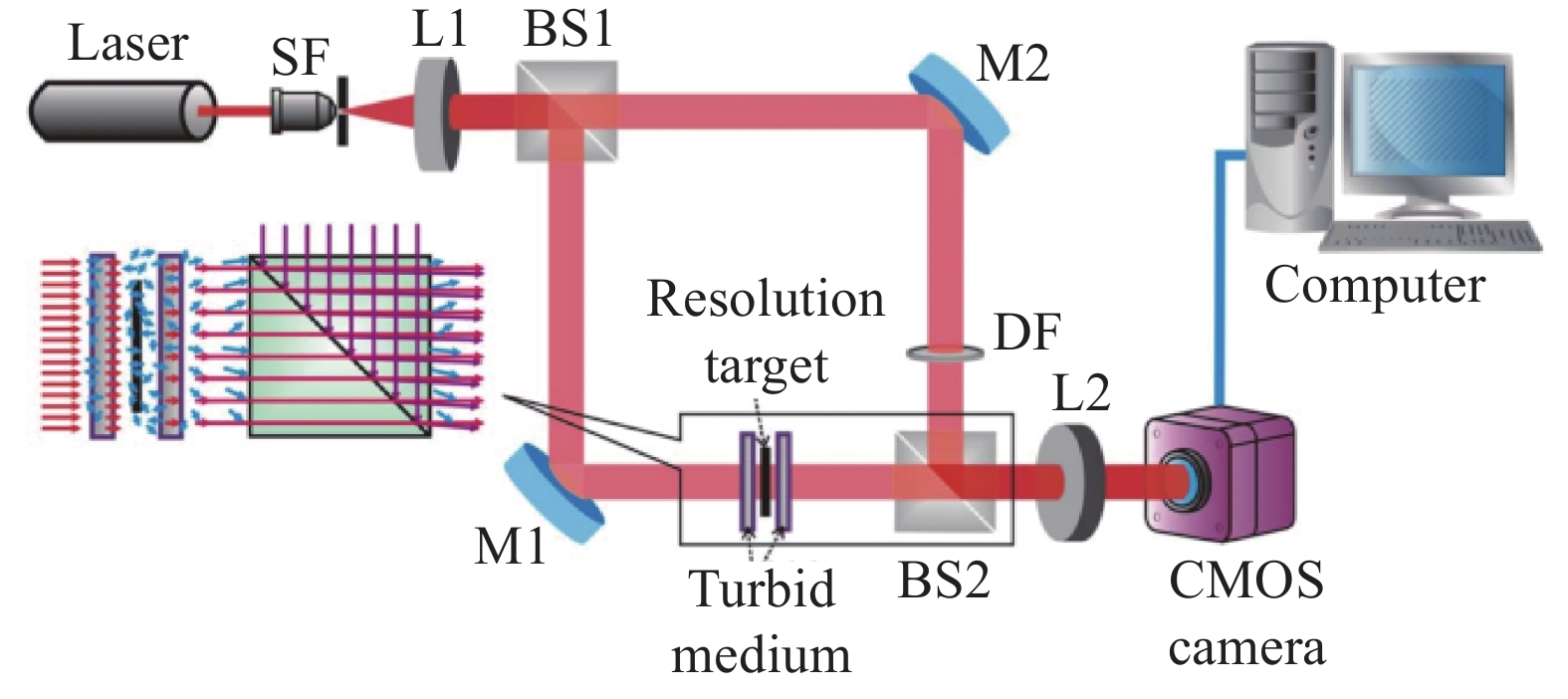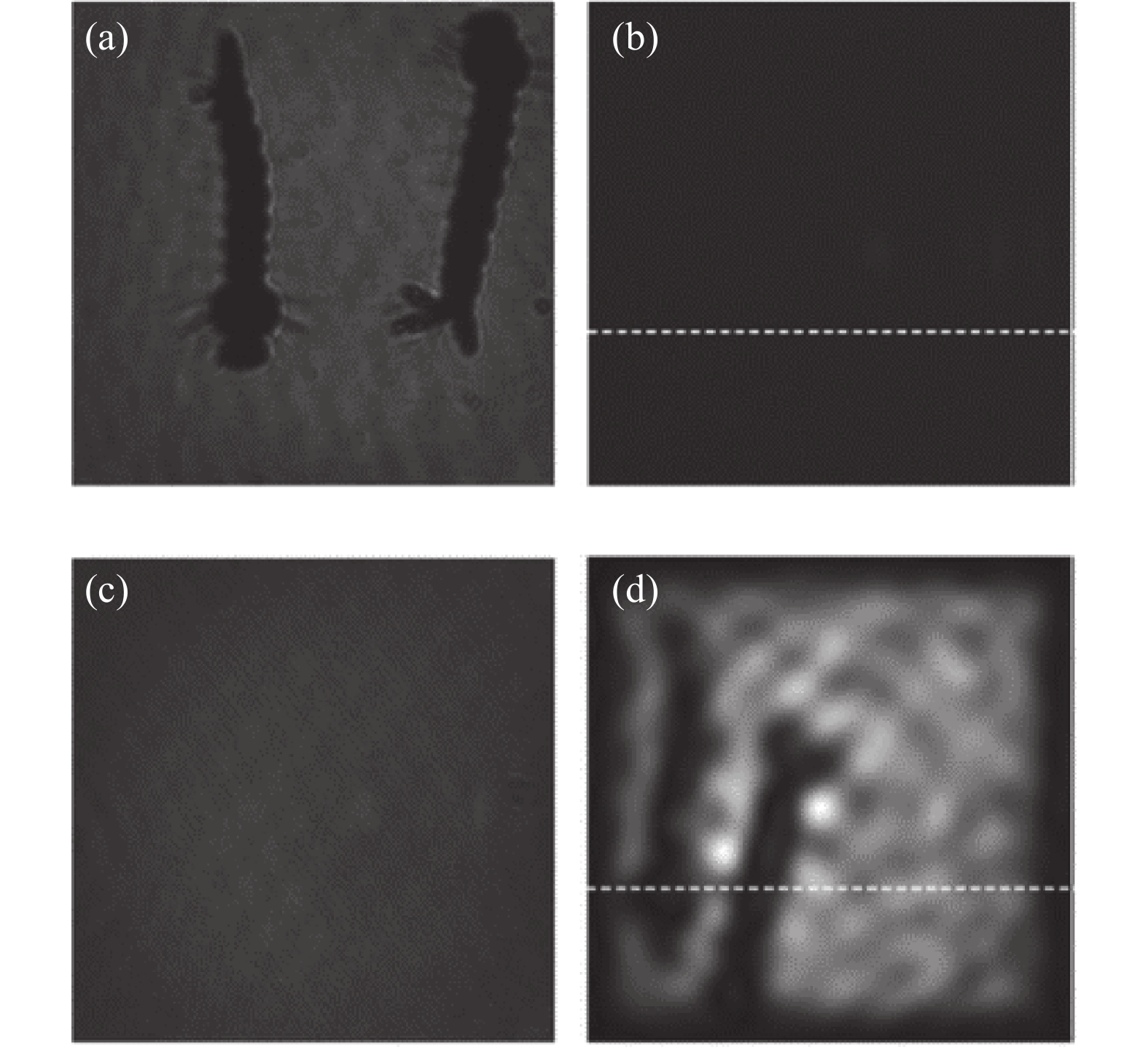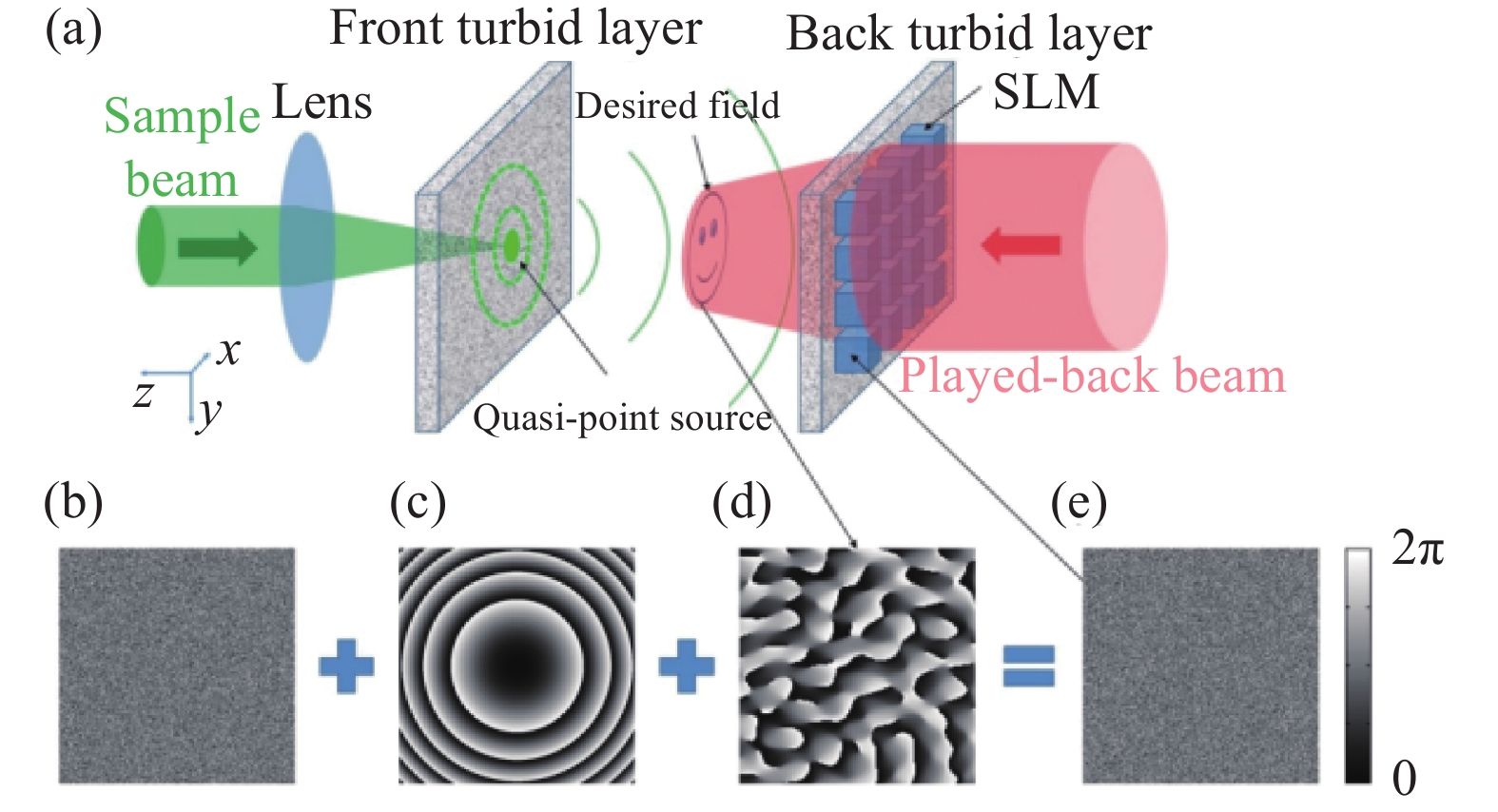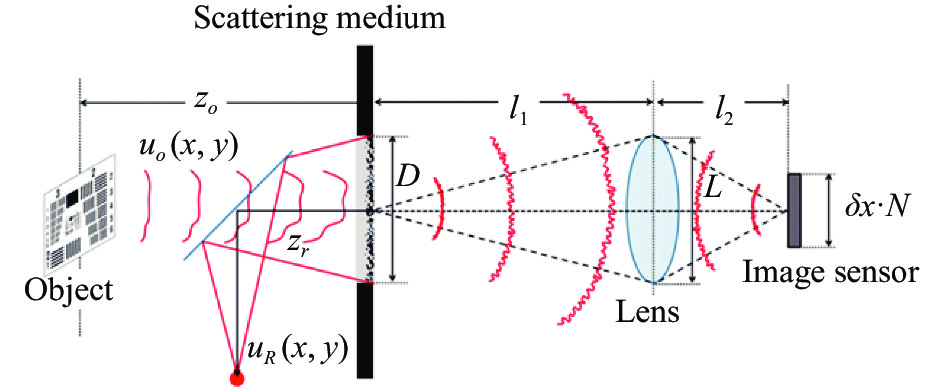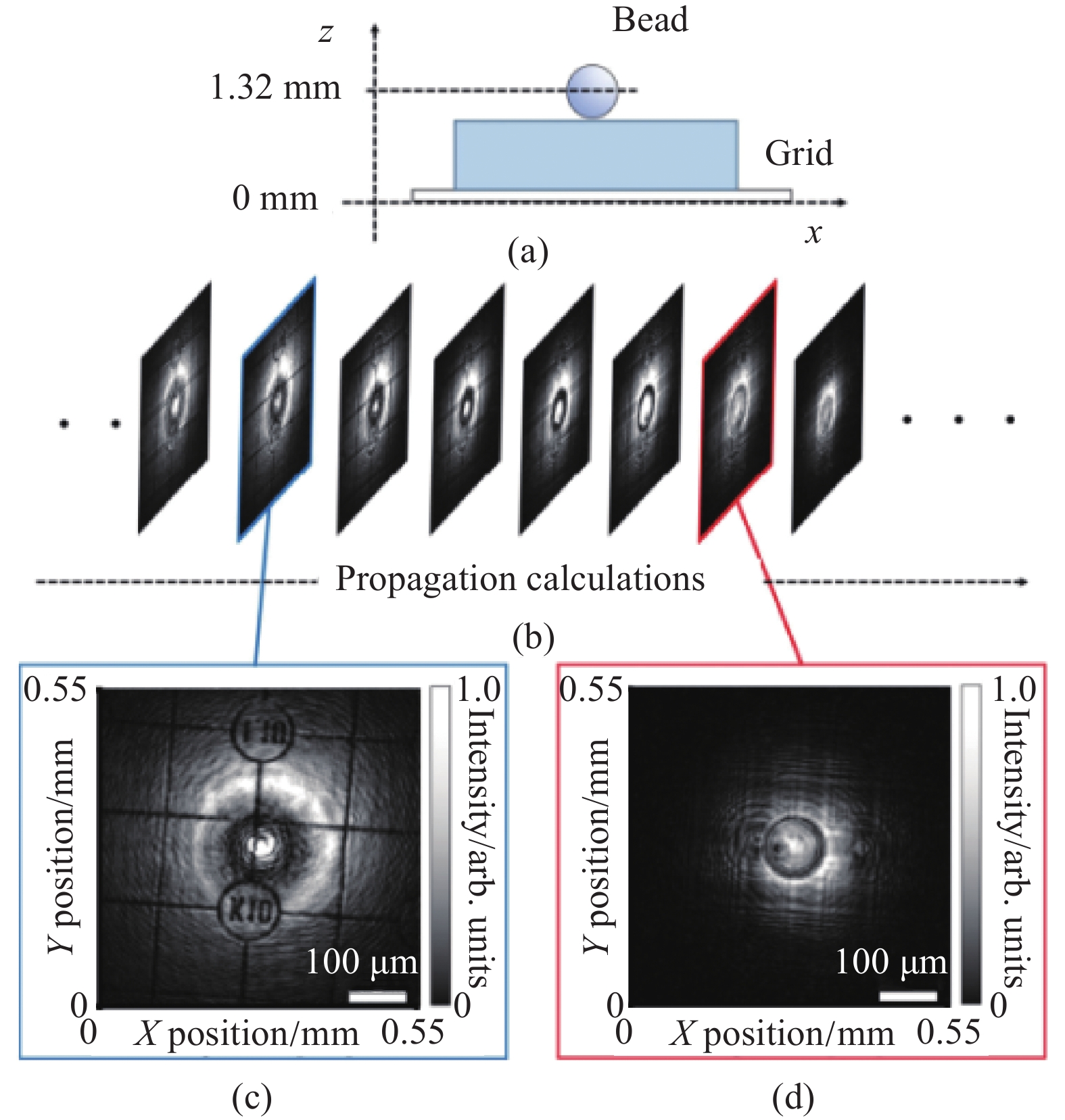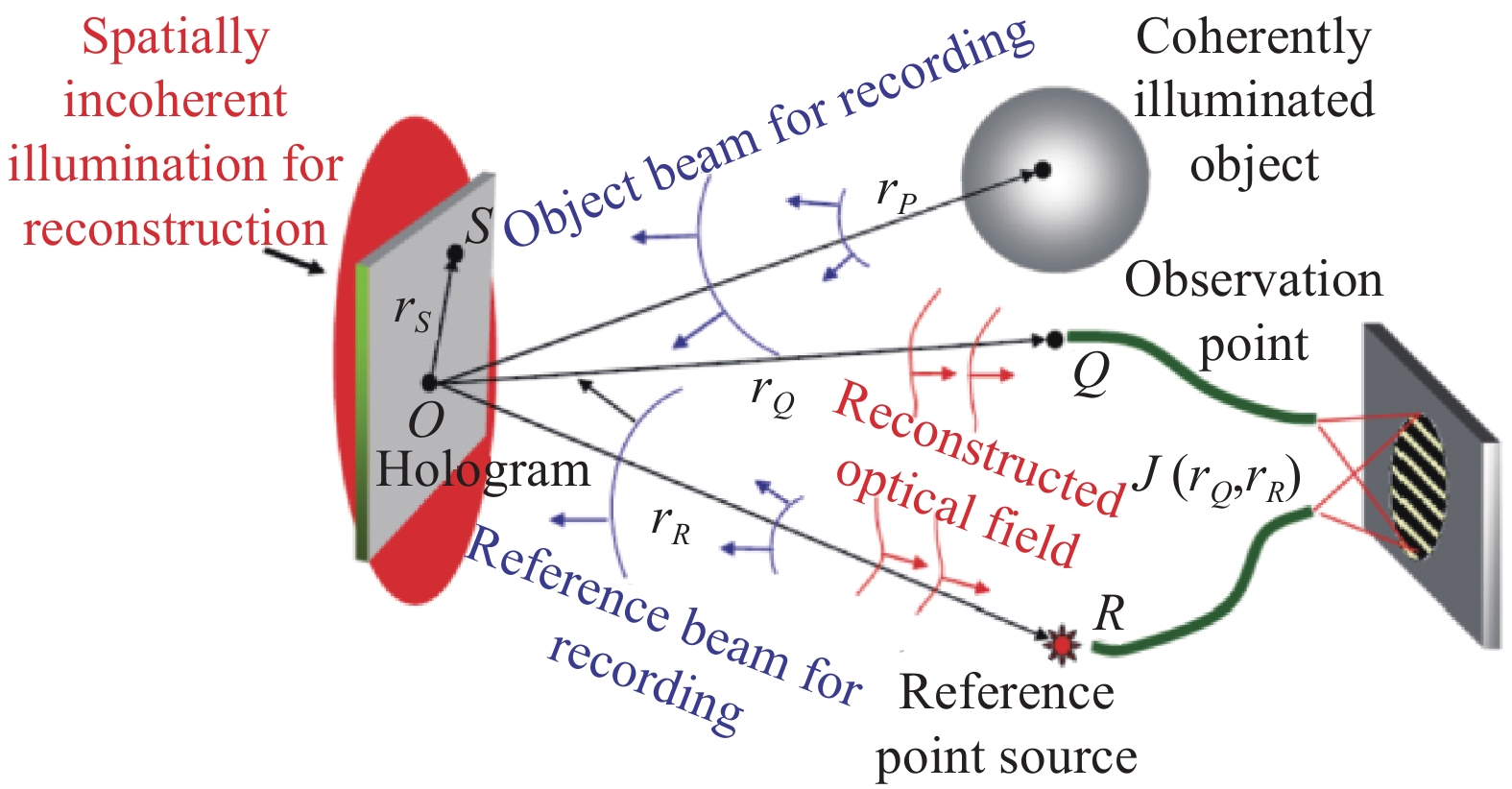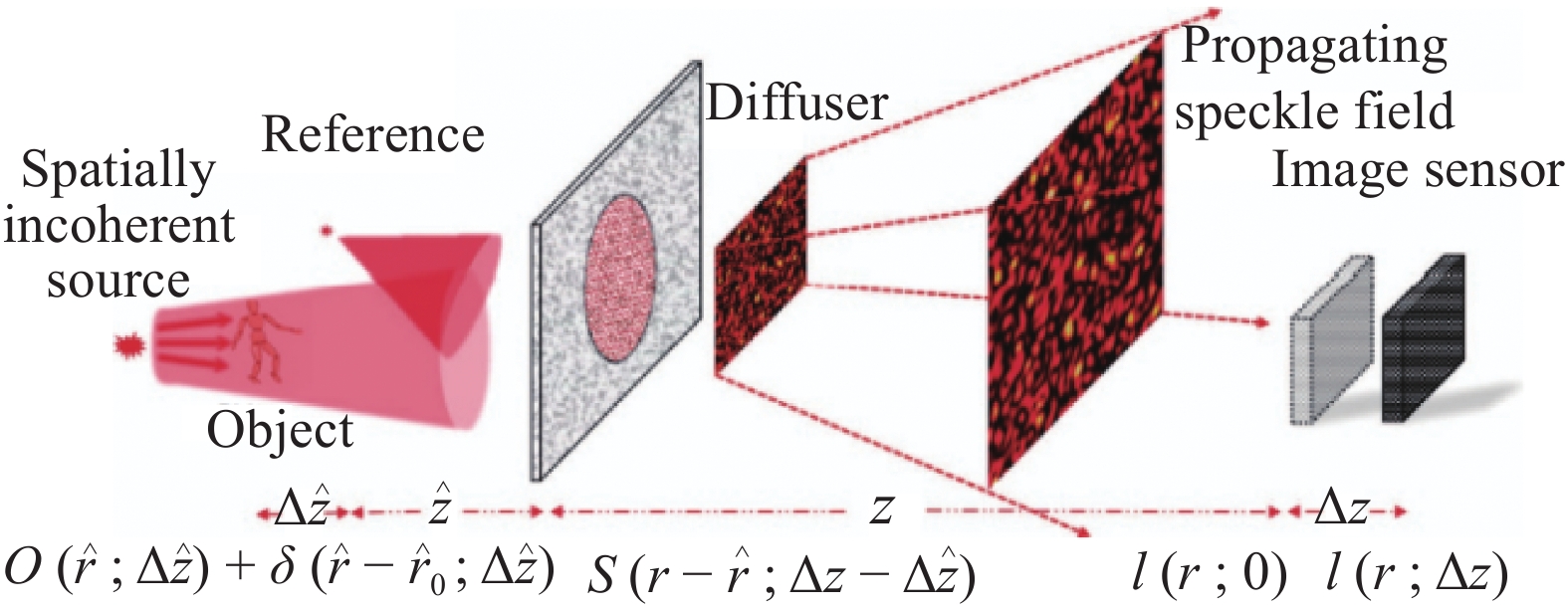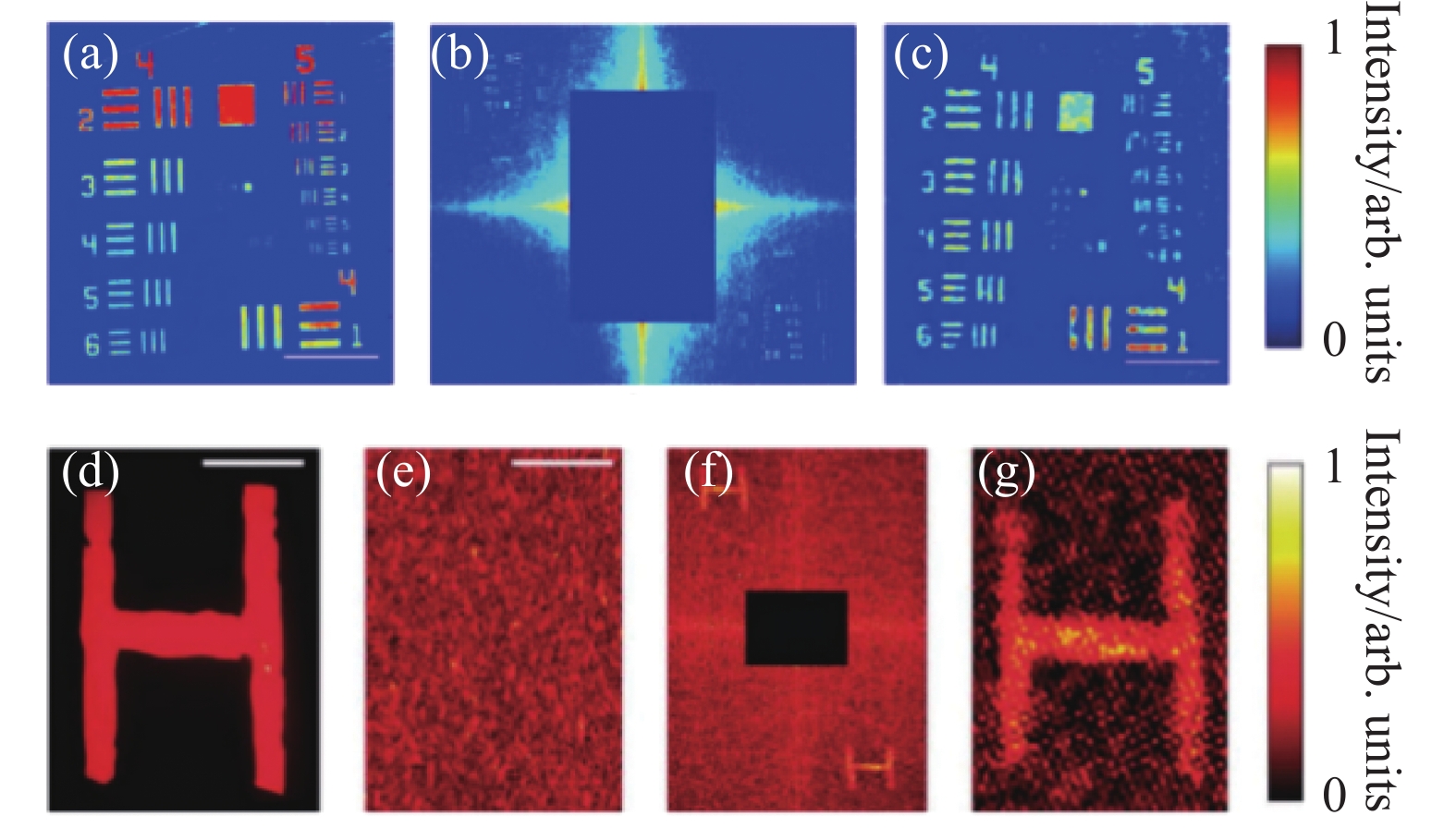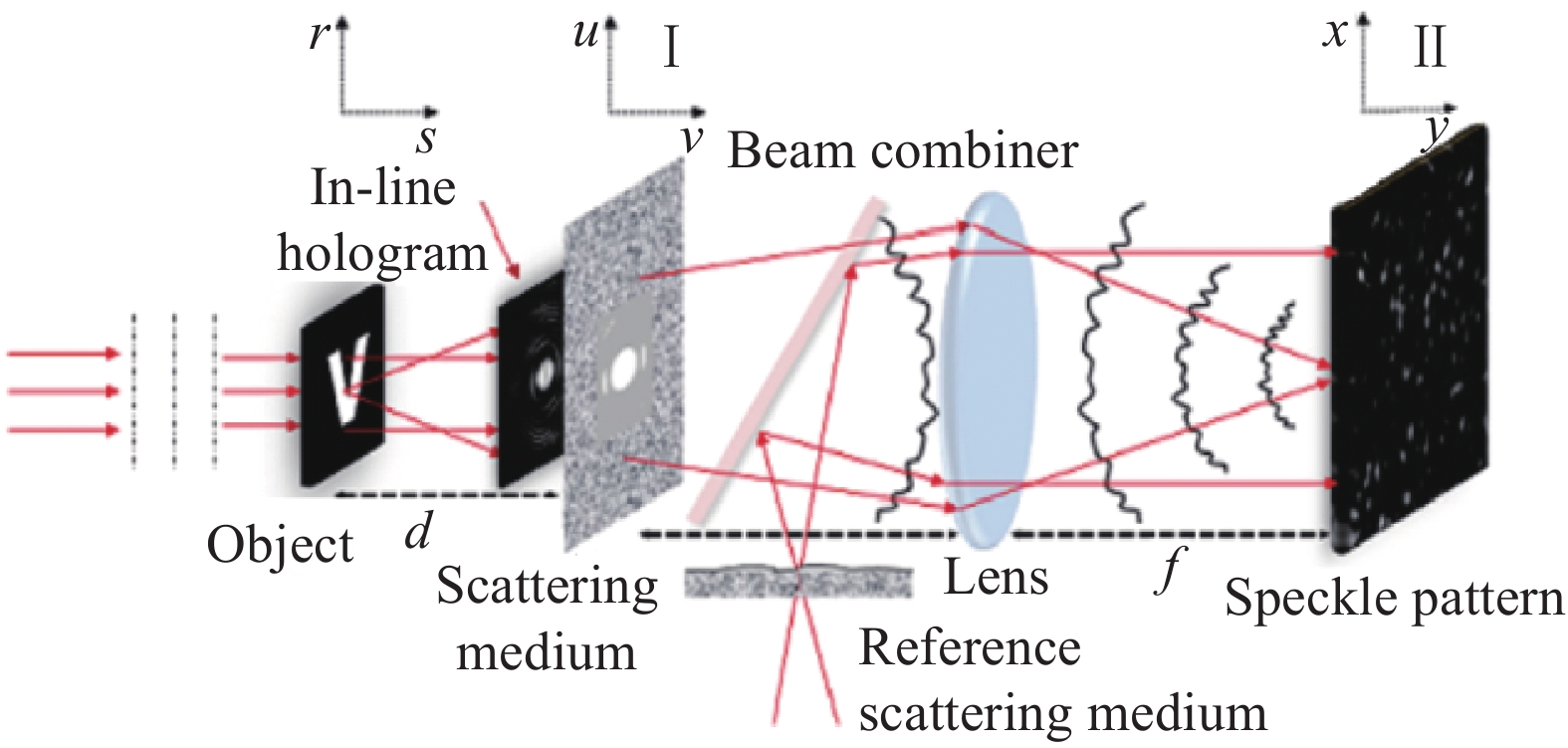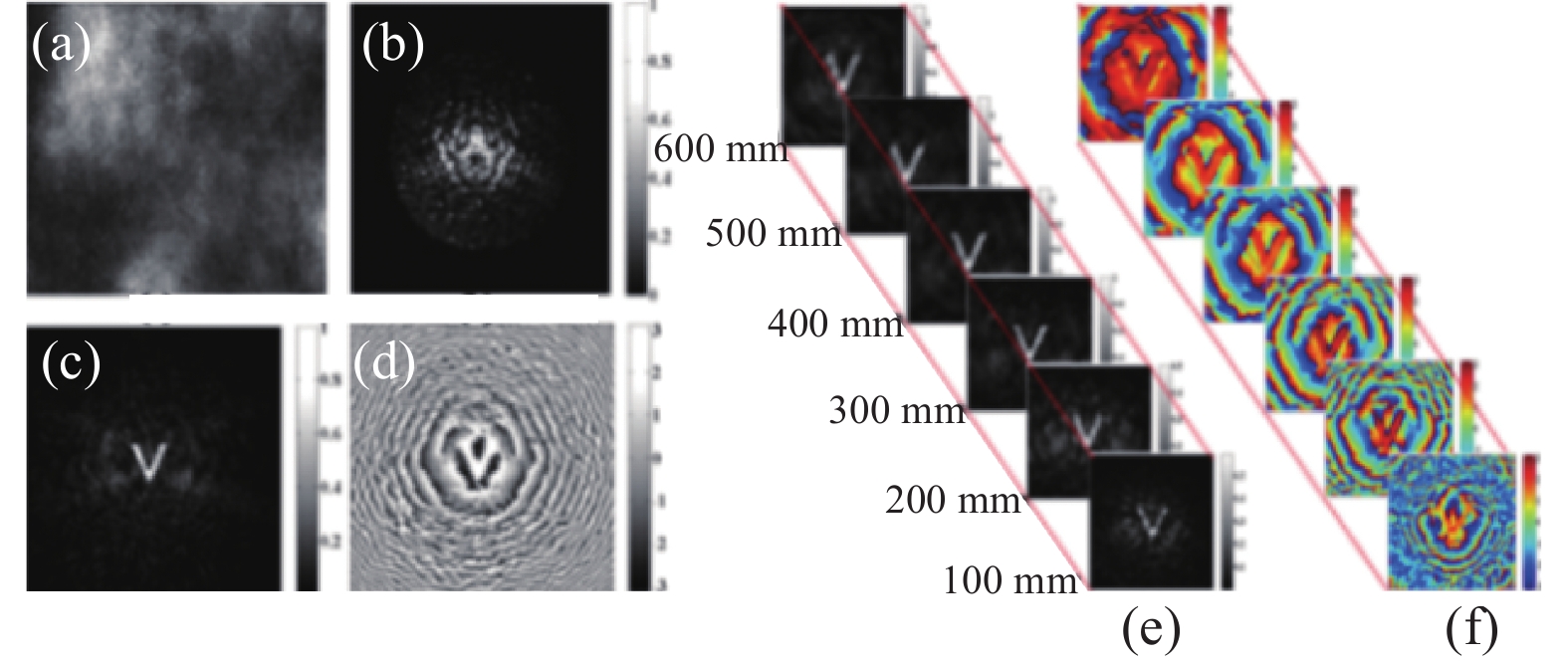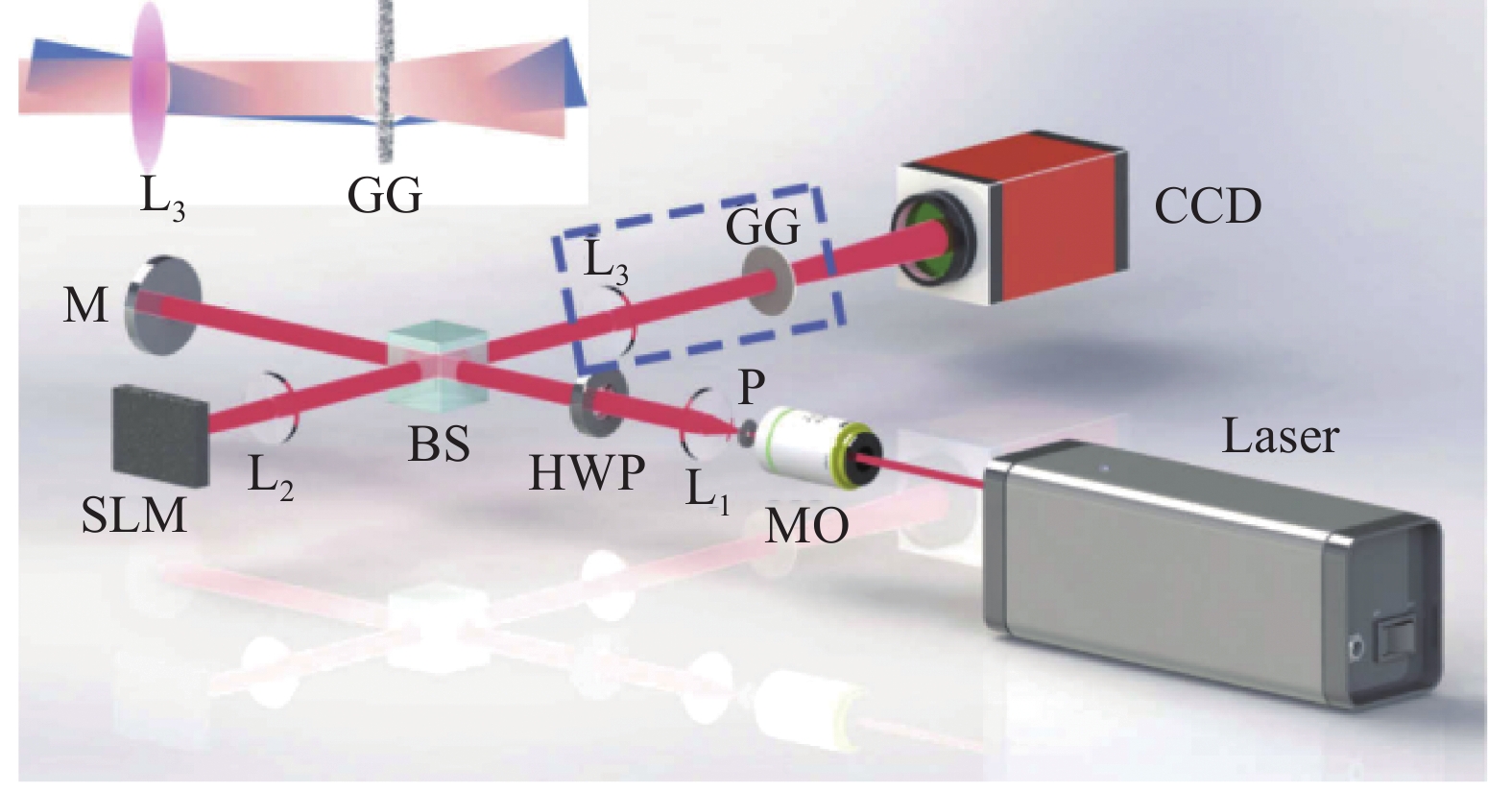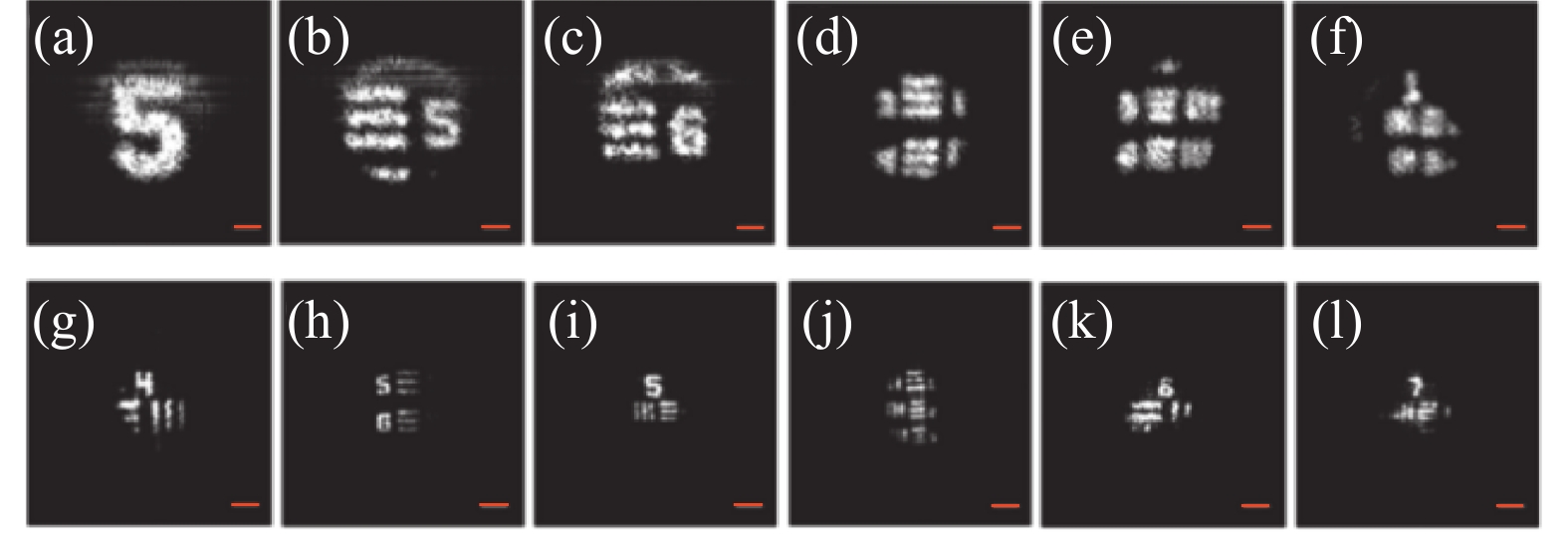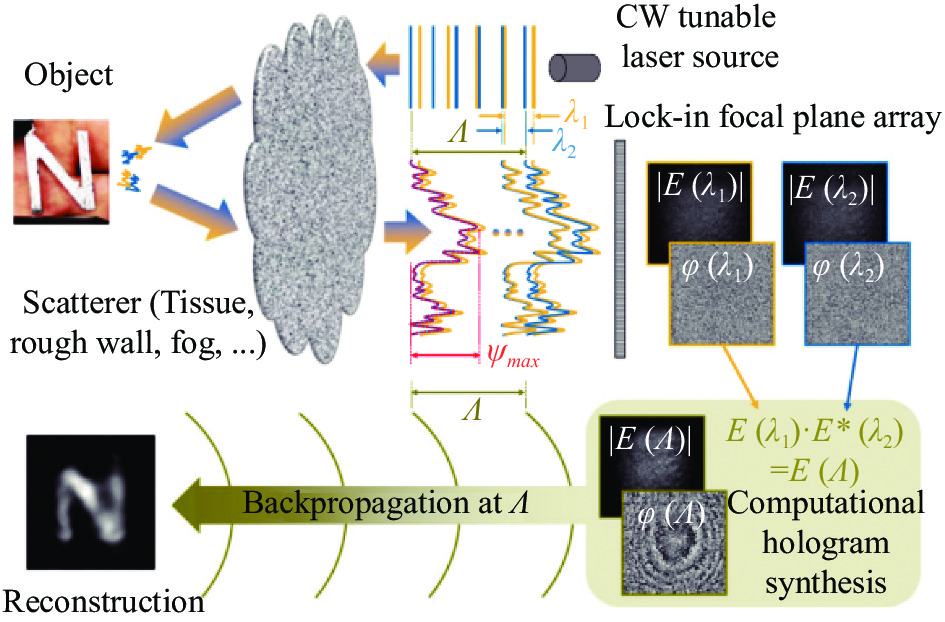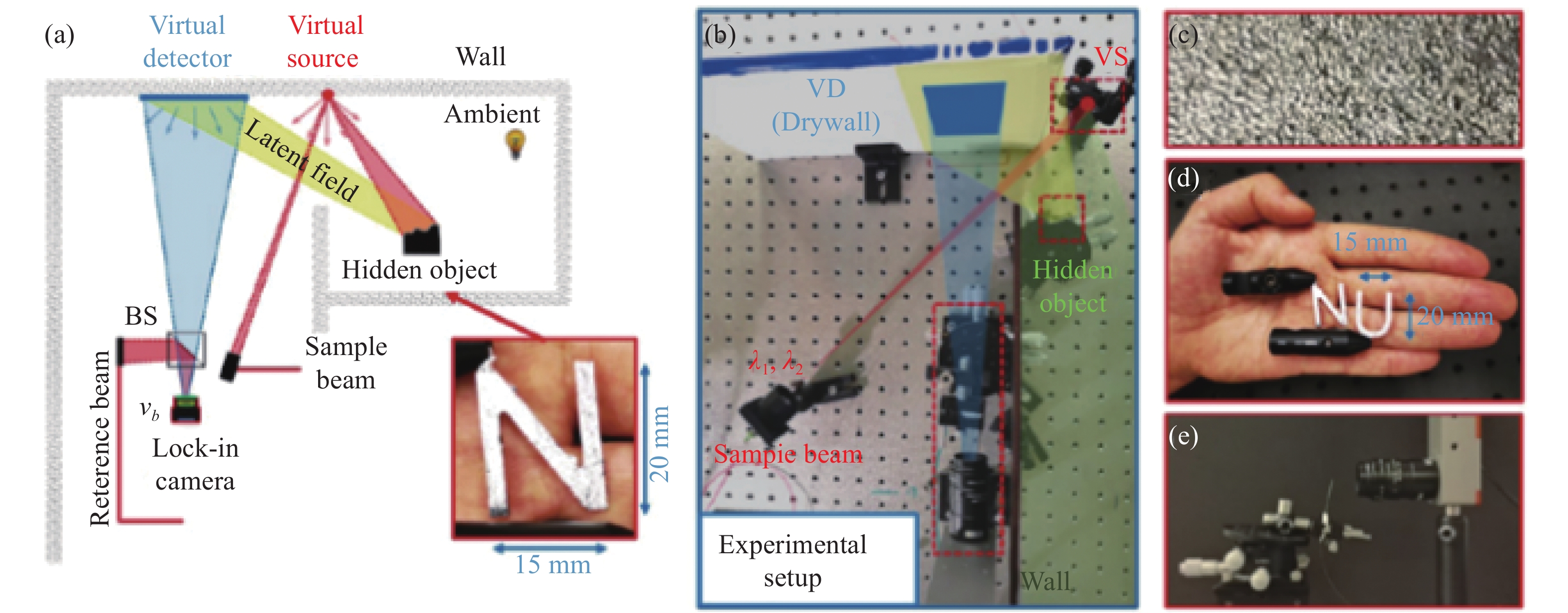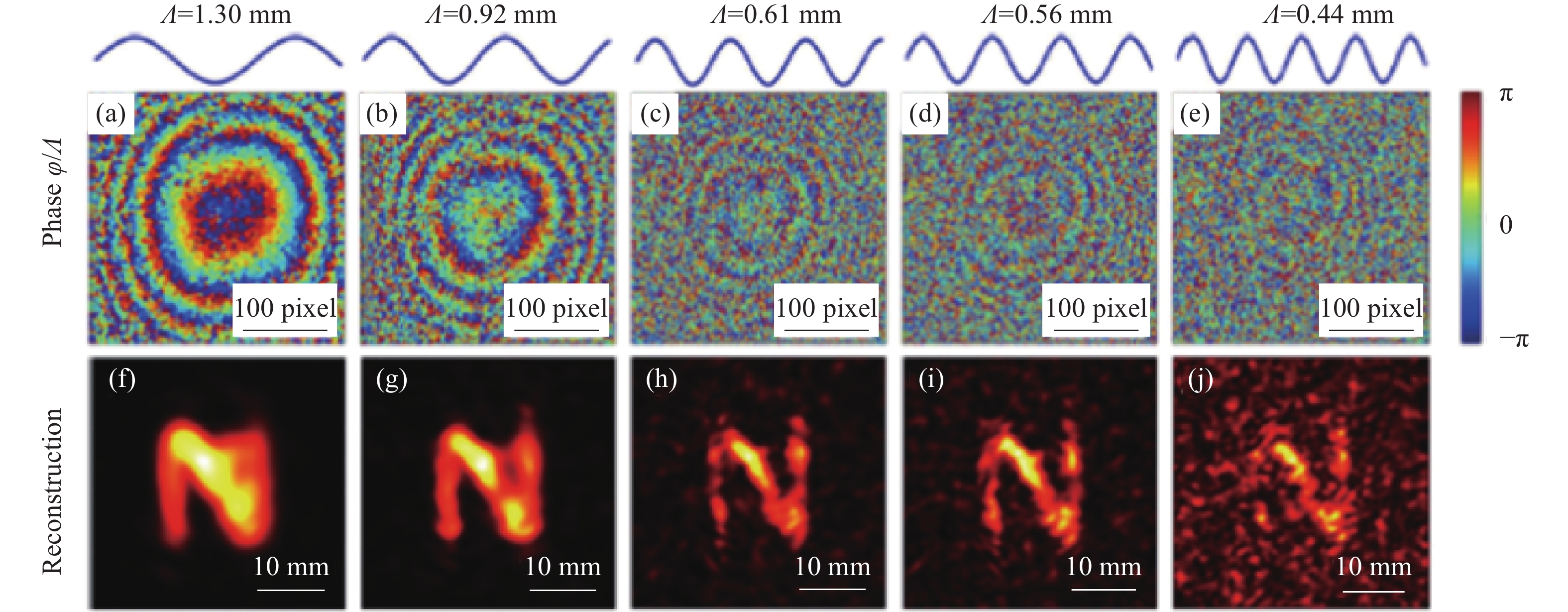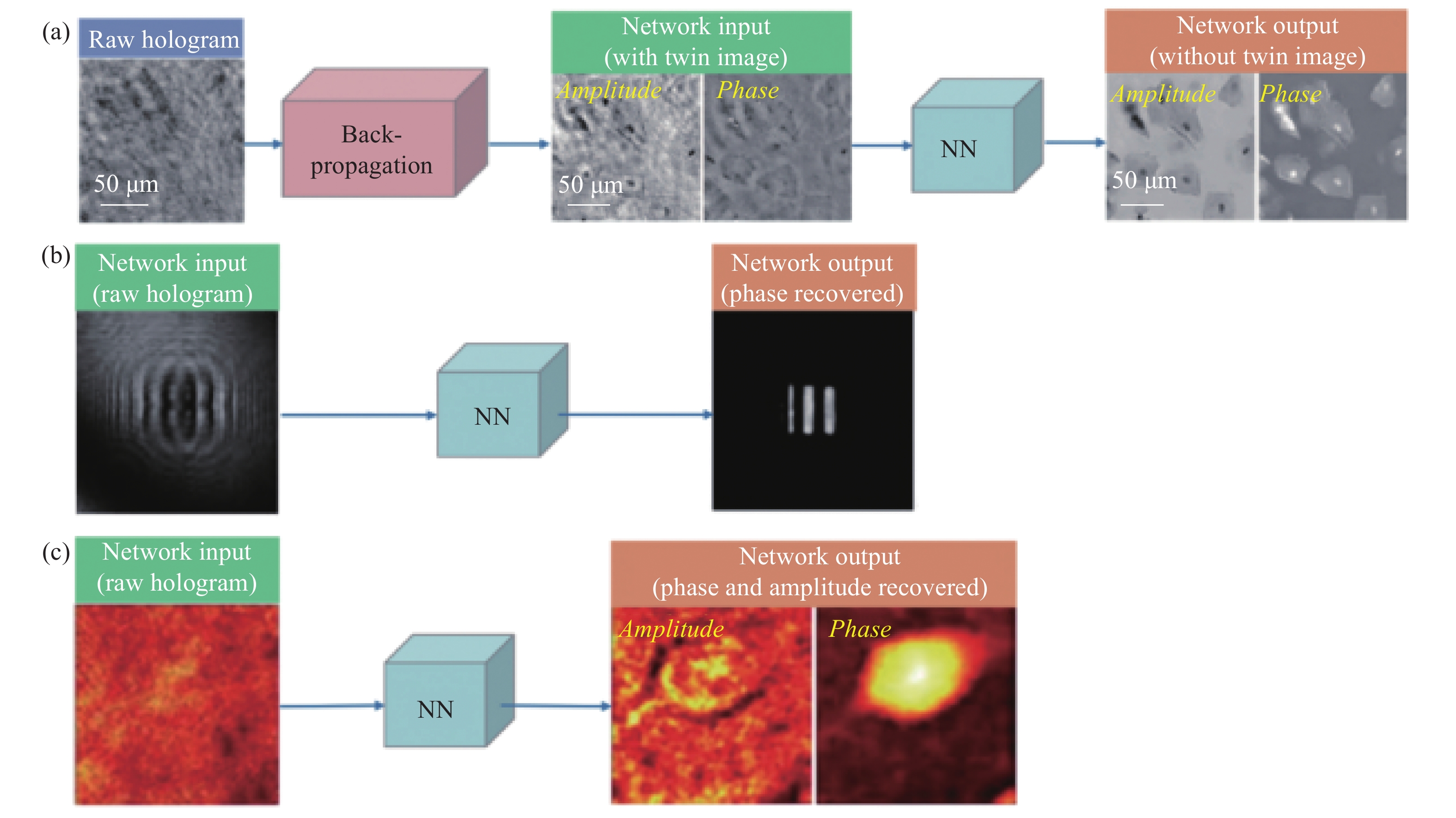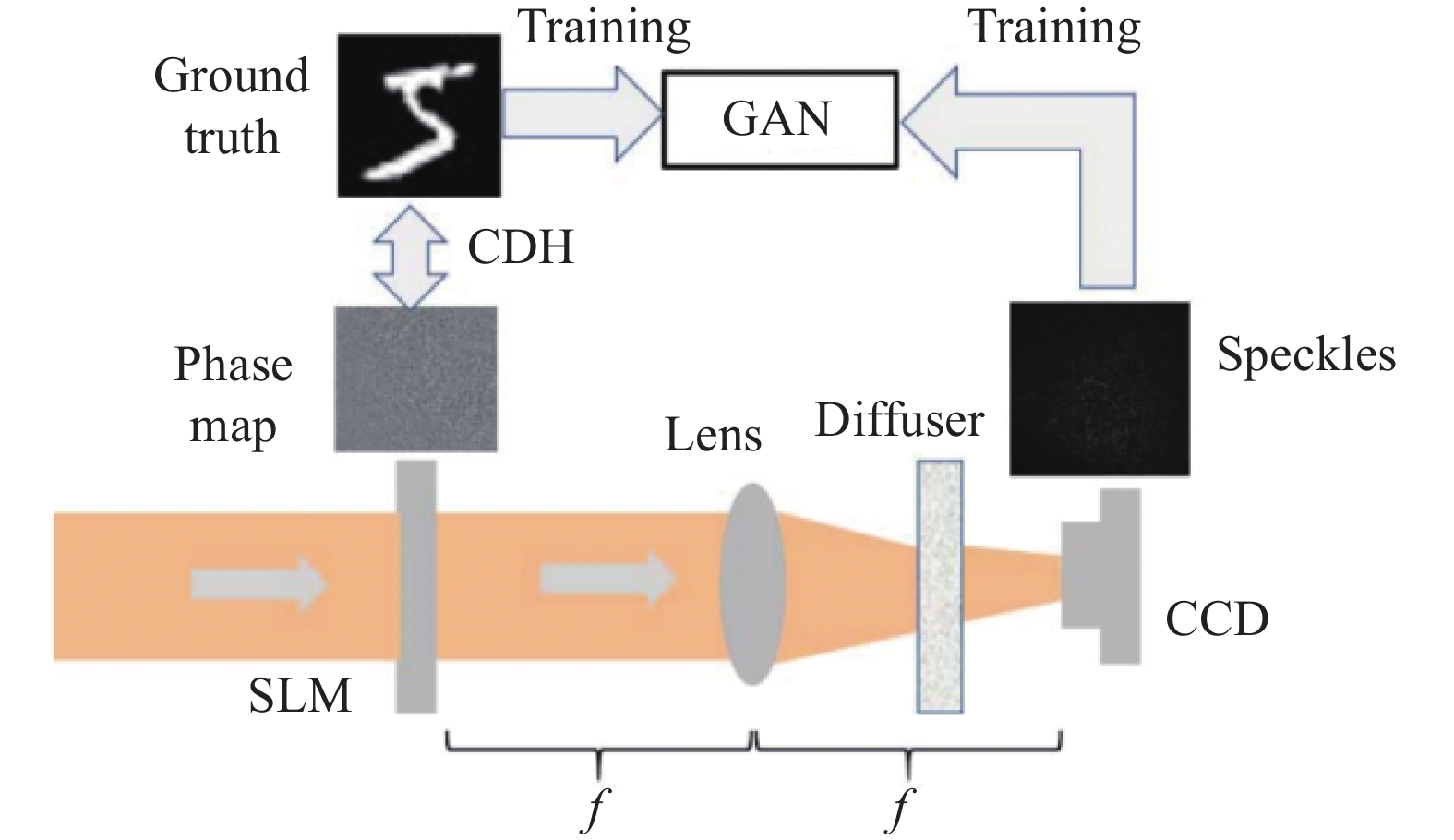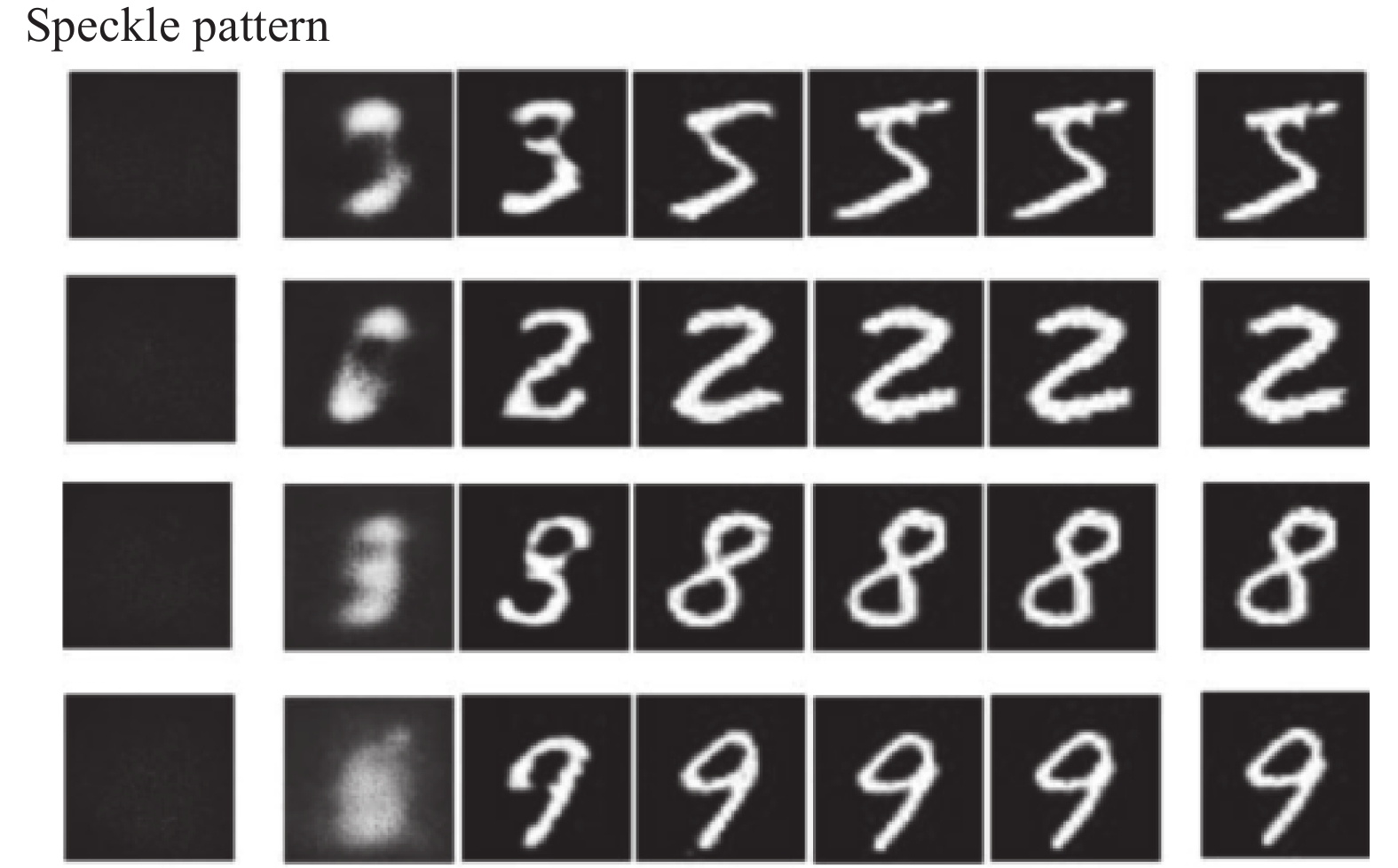-
光在传播时受到环境中介质分子或悬浮颗粒的作用而改变其光强分布、偏振状态或频率的现象称为散射[1]。在部分场景中散射会带来消极影响,例如雨雾天气下驾驶员难以看清道路;火灾现场的高浓度烟尘严重影响消防员的视野,增加救援难度;生物医学中皮肤、肌肉等会导致光线散射影响病情的判断等。在上述情况中目标光的信息被隐藏在杂乱无序的散射场中,致使传统光学难以直接对目标成像,发展可透过散射介质的成像技术是当前光学成像领域热点和难点。
虽然经散射后的随机无序光场看起来似乎是无法获取目标信息的,但是Freund等人发现的光学记忆效应[2-5]表明经散射作用后的光场会随小范围的入射角度变化产生相应的位移而不改变分布形态,即散射出射光波仍保留了原始目标光的有效信息。若能从散射光场中分离和提取出原始目标光的信息即可用于目标重建,从而实现穿透散射介质成像。近年来,更关注于信息的计算成像技术[6-7]迅速发展,区别于传统光学“所见即所得”的直接成像模式[8],计算成像技术在成像链路中引入主被动信息编码,实现信道扩容、维度提高,大幅提升成像信息获取及解译能力。在计算成像技术框架下,许多散射成像技术被相继提出,例如鬼成像技术[9-10]、散斑相关成像技术[11-12]、光学传输矩阵成像技术[13-14]等。
全息技术由Gabor[15]在1948年提出,能够同时恢复物体的振幅和相位信息,扩展了纯强度的光学成像能力。并且随着CCD(Charge Coupled Device)等光电探测器件以及计算机技术的发展,使用数字方式记录全息图的数字全息技术得以实现[16],具备无损伤、定量化和三维成像的优势,已经在生物医学显微[17-18]、光学信息加密[19-20]、信息存储[21-22]、干涉测量[23-24]等领域发挥了重要作用。
由于其独特的相位信息获取能力,全息技术在透散射介质成像领域表现出得天独厚的优势。1965年,Leith[25]将散射介质置于离全息图很近的位置处,散射介质的实像将被全息图重建,散射介质的原始相位与实像的互补相位互相抵消,消除了散射介质对成像的影响。这一研究成果启发了国内外学者将全息技术应用于实现穿透散射介质成像的技术研究中,取得了一系列突破性成果,例如基于全息门选通的散射成像技术[26-27]、基于相位共轭全息的散射成像技术[28-29]、基于相关全息的散射成像技术[30-33]以及基于双波长全息的散射成像技术[34-35]等,为解决穿透散射介质成像问题提供了新思路。文中主要就全息技术在穿透散射介质成像中的应用进行了分类归纳,介绍了几种具有代表性的技术的基本原理和研究进展,并讨论了下一步需解决的问题和未来发展方向。
-
穿透散射介质成像的实现离不开对弹道光或散射光的利用,其中弹道光是散射光场中未受散射作用的部分,通常只存在于穿透薄散射介质成像中且占比较少。若能将弹道光与散射光分离,即可对隐藏于散射介质后的物体进行成像。基于此思路,研究人员提出利用到达时间、空间分布、频率、相位、极化等差异性的门选通技术挑选出弹道光,实现了在浑浊水体中清晰成像等效果。全息技术干涉记录、衍射再现的基本过程对参与光波的空间相干性、时间相干性等要求高,具备天然的选通特性,基于全息的相干门控方法[36-37]被广泛应用于提升成像质量。近年来,研究人员将相干门控方法推广至穿透散射介质成像中,在实现去除散射光子背景干扰的同时还获取了成像目标的振幅和相位即三维信息。
2000年,Indebetouw等人[38]通过对光源空间上、谱宽上的扩展实现空间非相干性和时间非相干性的同时利用,并结合外差法进行探测。实验装置如图1所示,将普通苍蝇的翅膀置于载玻片,采用反射式装置进行穿透散射介质成像验证实验。该方法了实现对整个视场的单次曝光成像,并且可借助额外的探测时间和外差式相位检测进一步提高成像信噪比。
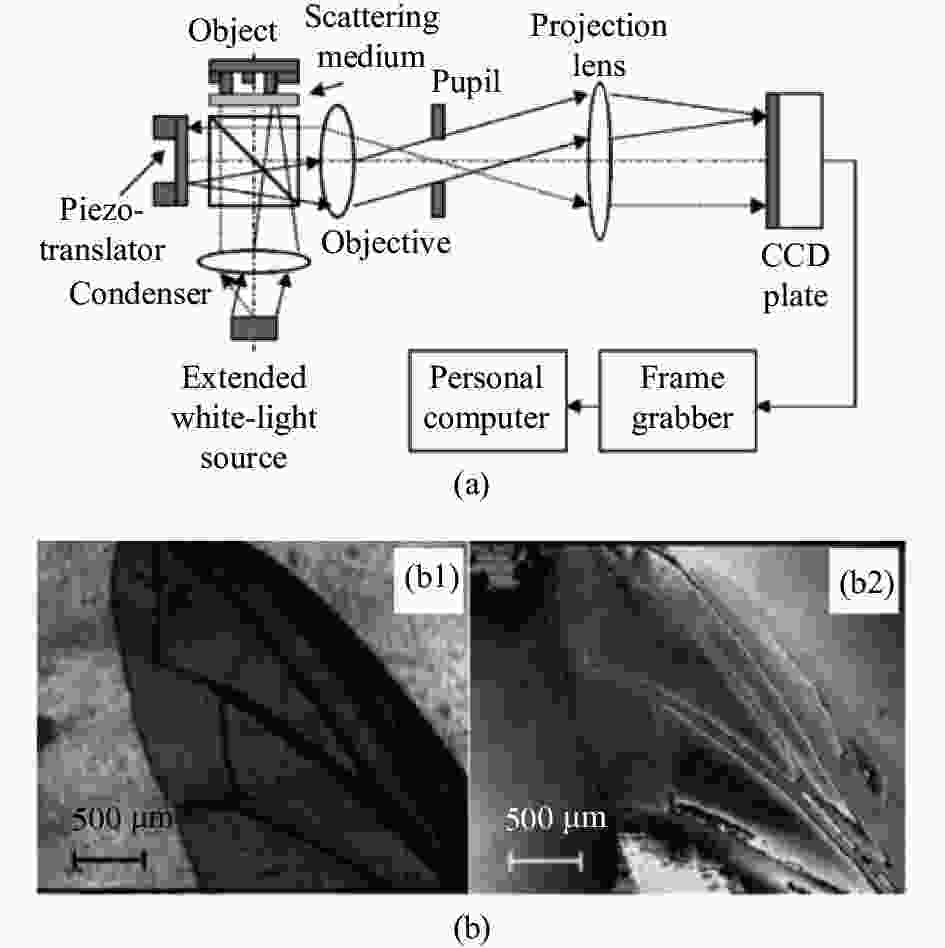
Figure 1. Scattering imaging based on low-coherence spatiotemporal holographic gating technology. (a) Experimental setup; (b) Experimental results: (b1) Amplitude, (b2) Phase [38]
上述工作所针对的散射环境尚停留在静态条件下,而在生物医学成像等领域中,需要在如细胞组织液等含有悬浮胶体颗粒的流动液体中进行成像,这种需求促进了新型紧凑型传感器和片上生物实验室技术的出现[39-40]。2012年,Paturzo等人[41]利用流动胶体中悬浮粒子的散射光子所产生的多普勒频移特性,结合数字全息技术实现在浑浊微流中的清晰成像,并指出该方法的适用条件为浑浊液体流速与相机曝光时间的乘积需大于成像视场。该方法开辟了一种新的非透明微流体中对物体进行成像的方法,可实现对浑浊介质中不可见物体的数字聚焦,特别适用于纯相位物体成像。通过对微流及静止液体中精子目标的成像实验,表明了该方法更适合于动态微流体,结果如图2所示,并对结构简单且紧凑的片上生物实验室提供了切实的可行性。
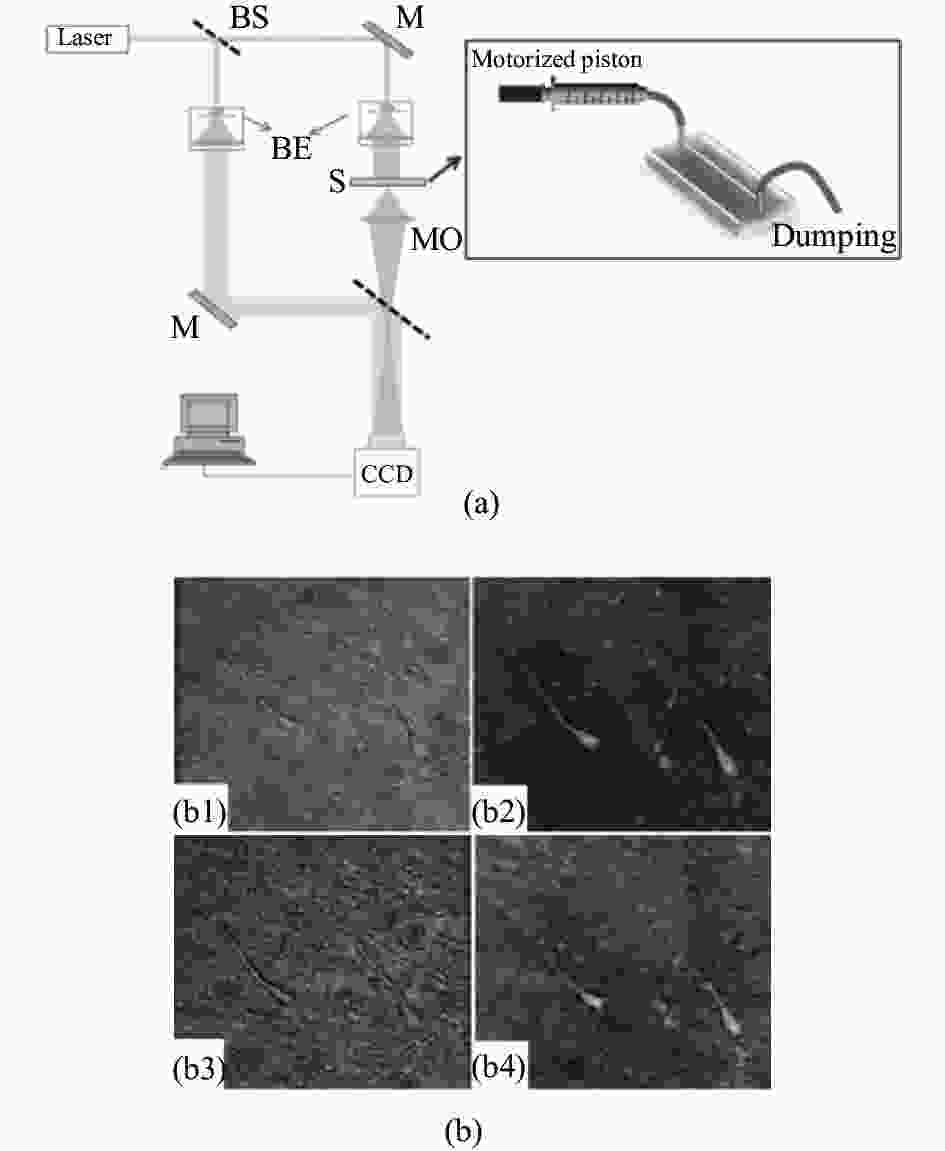
Figure 2. Schematic diagram of digital holographic scattering imaging in turbid water. (a) Experimental setup; (b) Experimental results: Reconstruction of sperm amplitude and phase in clean water (b1), (b2) and flowing milk (b3), (b4) [41]
2014年,暨南大学钟金钢等人提出了一种利用数字全息技术实现浑浊介质动态成像的方法[42],该方法主要应用了两种手段,一是通过在成像路径中设置聚焦面和光阑,实现对经散射介质的光波的空间滤波,保留弹道光和部分蛇形光成分;二是在数字全息重建中对数字全息图的角谱分量进行数字滤波,从而消除绝大多数散射噪声影响。图3为该方法在浑浊介质中成像的实验光路,图4为动态成像结果。该实验结果表明:可利用数字全息对带有目标图像信息的弹道光子和蛇形光子进行挑选,大大增强在浑浊介质中物体的成像对比度。
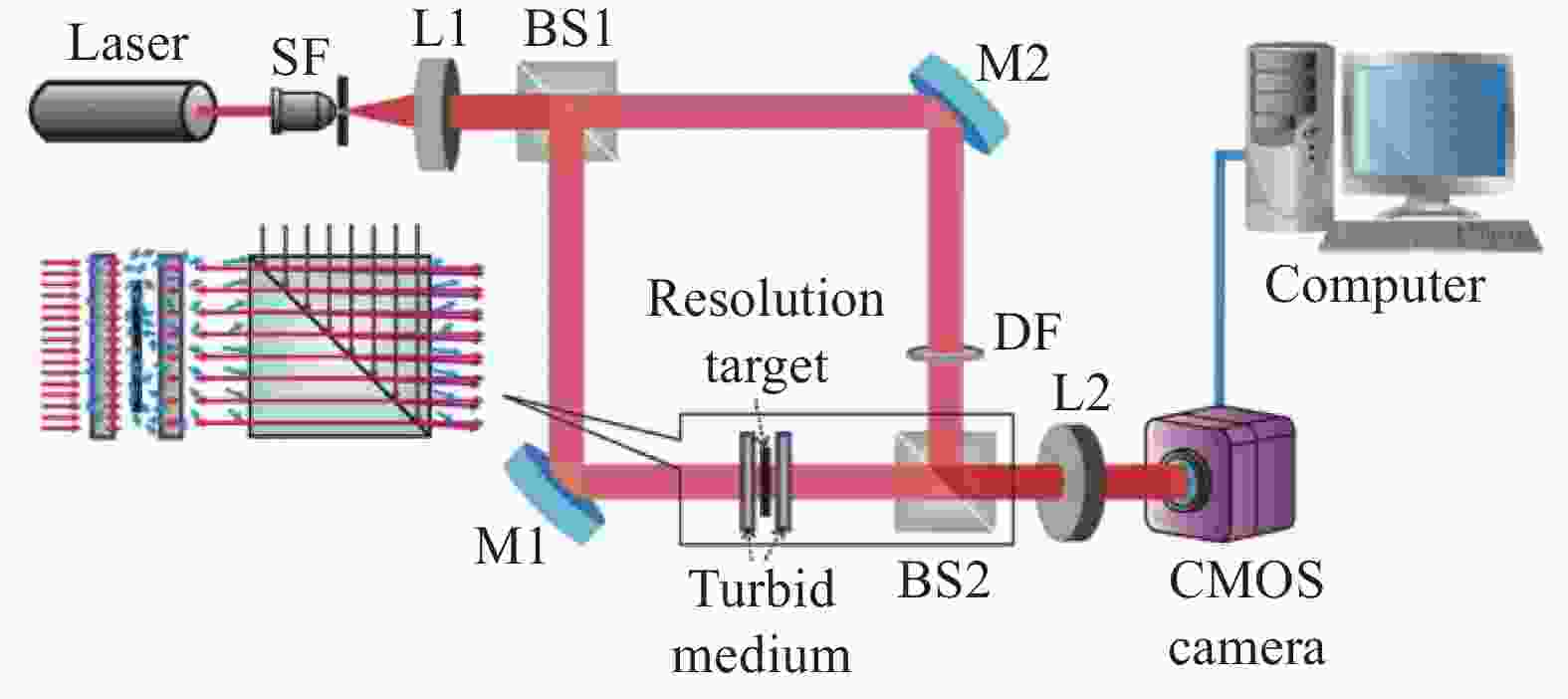
Figure 3. Dynamic imaging optical path through scattering medium[42]

Figure 4. Dynamic imaging results. (a) Image of mosquito larvae observed directly in water without reference beam; (b) Image of mosquito larvae observed directly in opalescent medium without reference beam; (c) Digital hologram of mosquito larvae observed in turbid medium; (d) Corresponding angular spectrum reconstructed intensity image[42]
基于全息门选通技术的穿透散射成像方法的原理和光路较为简单,且往往能用于动态散射介质环境中,特别适用于生物医学组织细胞分析中。但其本质仍为利用未受散射介质影响的部分光,随着散射介质厚度的增加,其成像对比下降明显。当经散射介质的光为完全散射光时,该类方法将失效,这也是制约门选通类成像技术的通病。
-
相位共轭光波也被称为时间反演光波,它基于光传播的可逆性,通过记录散射场的振幅和相位信息,获得透过介质后的光场分布,再反向输入透射光场的相位共轭波,从而重建物体的理想像。光学相位共轭的实现分为:光场信息的记录和相位共轭光的生成。2008年,Yaqoob等[43]将相位共轭技术用于抑制生物组织的散射效应,实现了光束通过生物组织成像和聚焦。
为了消除由散射介质引起的波前畸变,2010年 Cui等人[29]将传统的光折变晶体替换为CCD和空间光调制器(Spatial Light Modulator, SLM),提出了一种数字光学相位共轭技术(Digital optical phase conjugation, DOPC),该技术基于四步相移数字全息术,从得到的四幅全息图中提取出目标光的复振幅信息,将相位信息传递给SLM输出相位共轭光波,使该共轭光波按原路返回散射介质,有效补偿了散射介质引起的波前畸变,实现目标光束的重建。实验光路如图5所示。

Figure 5. Schematic diagram of phase-conjugate imaging based on digital optics [29]
但上述方法所补偿得到的成像面与被成像目标在同一位置,对于实际成像情形而言是不实用的。2017年,中国科学院上海光学精密机械研究所韩申生课题组提出一种非侵入的数字相位共轭技术[44],利用聚焦透镜在前散射介质层上产生一个点光源(如图6绿色路径所示),向后散射介质发射一个准球面光波,用SLM对逆向的参考光束(红色路径)进行调制,得到一个堆叠的相位图,最后利用相位共轭的方法对堆叠的相位进行测量与恢复。该方法可以与鬼成像技术或者压缩感知技术相结合,实现两个散射介质层之间物体的三维成像,由于其独特的三维光控制能力,该技术可以应用到光学治疗与光遗传学中。但是该方法受限于光学记忆效应,难以实现宽视场成像。

Figure 6. Schematic of the presented approach for light control between two turbid layers. (a) Schematic of experimental setup; (b) Conjugated phase map of the sample beam; (c) A quadratic phase map; (d) A pre-calculated phase map; (e) Phase diagram superimposed by (b), (c) and (d)[44]
2019年,Kodama等人[45]开发了一种同轴相移数字全息的散射介质三维显微镜成像系统,光学系统原理见图7,该系统改进了传统的同轴数字全息系统,使用同轴相移球面作为参考源来获得散射介质的共轭相位,从而获得隐藏在散射介质后的目标信息。通过适当调整聚焦点的位置可以获得不同深度的图像,将物体不同深度的图像全部获取,就能够实现对物体的三维重构,结果见图8。

Figure 7. Schematic diagram of coaxial phase-shift digital holographic 3D imaging optical system[45]
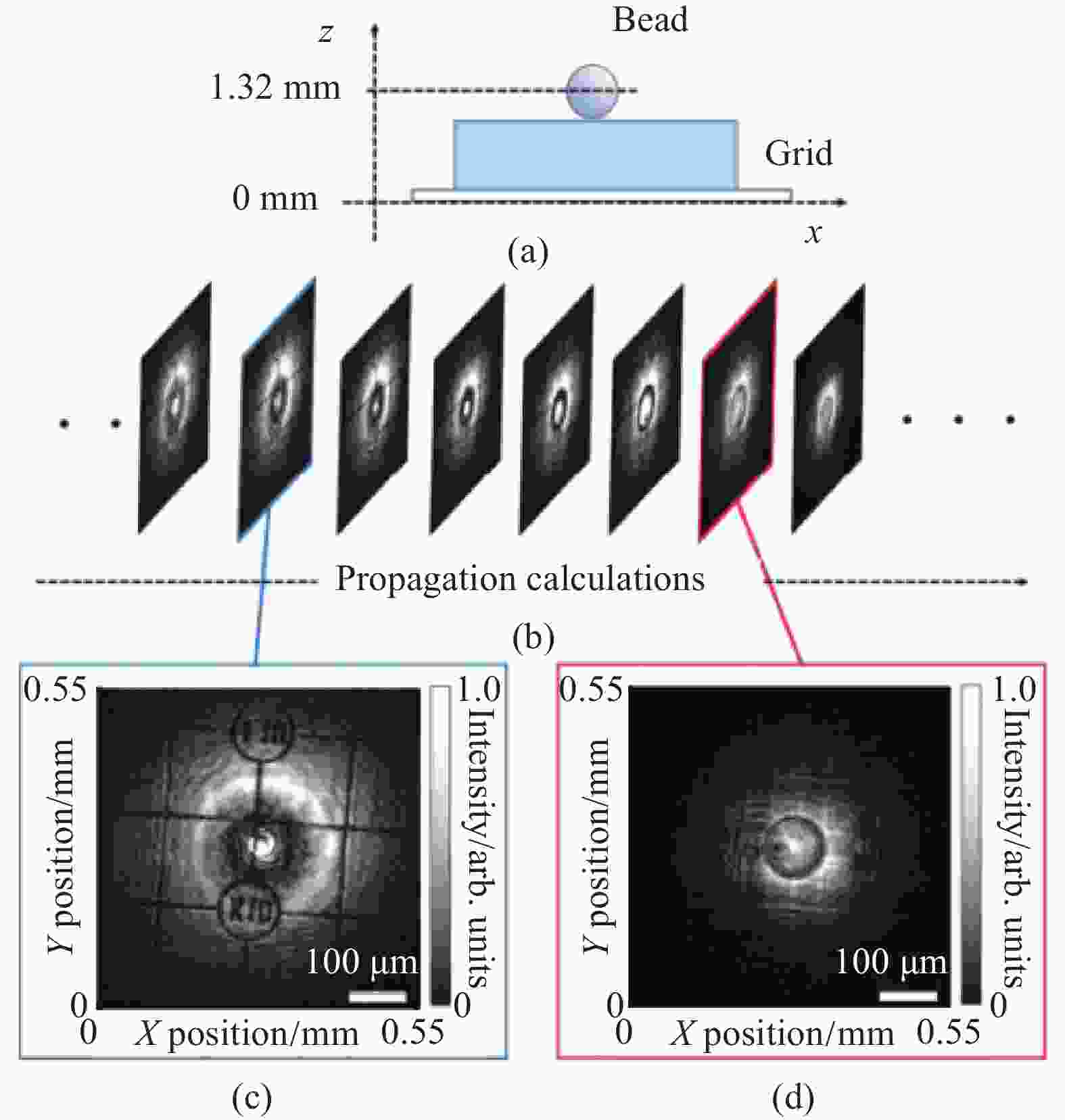
Figure 8. Recovered results of three-dimensional imaging based on in-line phase-shift digital holography. (a) Structure diagram of imaging target; (b) Reconstructed three dimensional slice results; Reconstructed image with a focus on (c) the grid and (d) the glass bead[45]
相位共轭全息的散射成像方法要求相位共轭光路严格遵循位置对齐,稍有偏差就会影响整体系统的稳定性,对于动态散射介质成像的应用有限。
-
基于相关理论的全息散射成像技术主要包括散斑相关全息[46-48]以及相关全息技术[49-51],两者都是通过散射场的强度相关计算出隐藏目标强度的自相关函数实现透过散射介质成像的。其中,散斑相关全息是利用相位恢复算法恢复目标相位信息,相关全息则是将散斑的自相关函数重构为空间相干函数来恢复目标相位,见图9,观察点Q与参考点R之间的相互强度等于用相位共轭参考光束照射具有相同振幅透射率的全息图所再现的光场,因此互强度可以用来重建物体的复振幅信息。重构的相关图像为干涉条纹图,不能直接观测到,只能通过使用适当的干涉仪观察。

Figure 9. Recording and reconstruction of coherence holography[52]
2010年,Naik等人提出了一种能够实时记录和重建的相关全息技术[30](见图10),并通过莱斯型相关全息图进行了实验验证。相关全息图由马赫-曾德尔干涉仪实时生成,再由Sagnac横向剪切干涉仪重建,实验结果见图11。由于Sagnac 横向剪切干涉仪受外界振动、气流等因素的影响较小,抗干扰能力强,使得重建系统具有很高的鲁棒性。利用该方法可以得到具有理想空间相关函数的光场分布,并将相关函数可视化为干涉条纹图中的对比度和相位变化。对于三维物体的重建,只需要将CCD相机聚焦到Sagnac横向剪切干涉仪输出的不同深度位置即可,由于横向剪切与深度无关,因此在不同深度重构的目标光波具有相同的放大倍数。该方法中使用的散射介质为旋转毛玻璃,虽然能够降低全息系统的噪声,但在实际应用中的适用性不强。
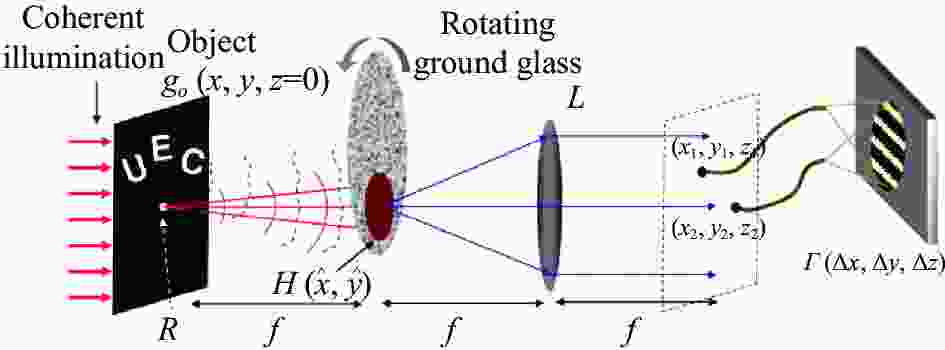
Figure 10. Interferometric measurement implementation of holographic correloscopy for imaging through a scattering medium[30]

Figure 11. Reconstructed images. (a) Raw intensity image resulted from shearing interference in real time; (b) Fourier spectrum of the interference image and (c) Contrast image of the coherence function[30]
为了验证散斑强度自相关能够实现三维成像,2017年,Singh等人提出一种空间非相干无透镜成像技术[53],实验装置见图12,通过将散射介质视为虚拟的成像透镜,在目标附近引入一个参考点源,采用空间非相干准单色光照明目标,结合散斑强度相关性的全息相关原理实现三维目标的重建,结果如图13所示。该方法无需使用三维迭代相位恢复算法,减少了计算的负担,对物体的稀疏性没有限制,具有更广泛的适用性,光路结构简单且可调聚焦深度,在透散射介质三维成像领域具有较大的潜力。
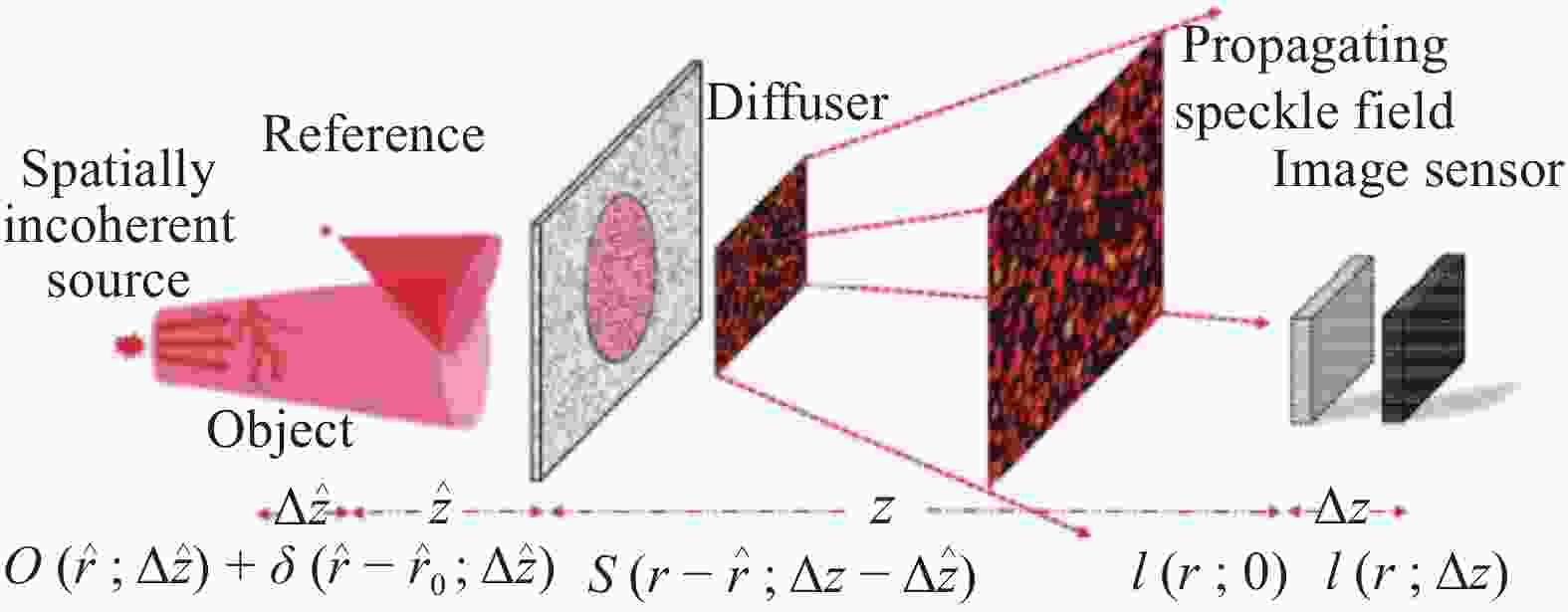
Figure 12. Schematic diagram of holographic scattering imaging based on speckle intensity correlation[53]
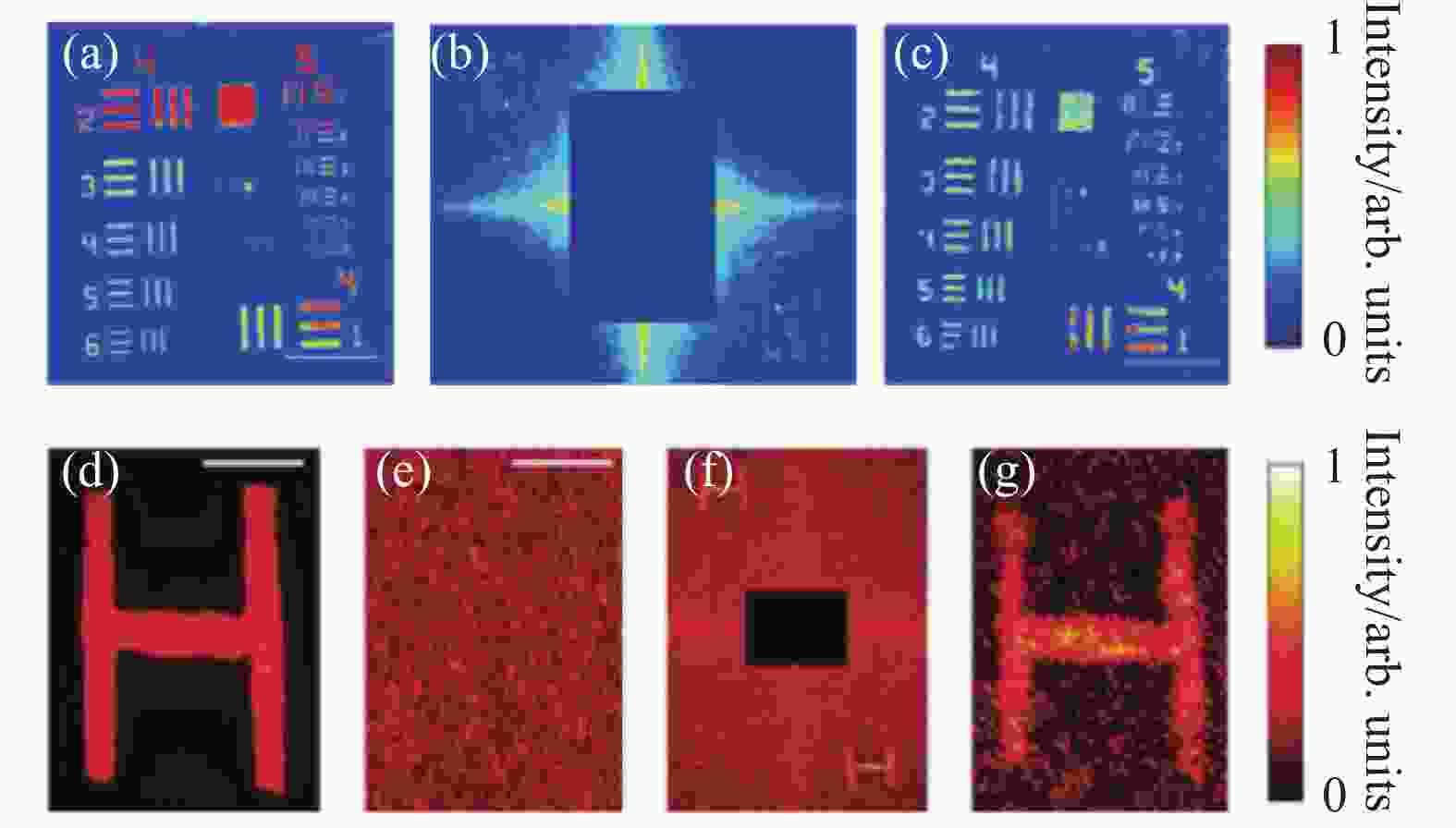
Figure 13. Experimental results. (a) Original object; (b) The autocovariance of the speckle intensity pattern and its central correlation peak are blocked; (c) Refactoring the object; (d) Original object; (e) Speckle intensity of light scattered through biological tissue; (f) The autocovariance of the speckle intensity pattern and its central correlation peak are blocked; (g) Refactoring objects[53]
2019年,Vinu等人提出了一种无需物空间参考点源的散射光场单帧成像技术[54],成像光路如图14所示,该技术利用散斑强度的自相关特性,通过参考光波的干涉,使同轴全息图与远场散斑图像相互叠加产生强度相关图,利用傅里叶变换从远场散斑图中恢复出散射介质后面的目标同轴全息图,然后运用数值重建算法重构三维散射光场,进而从随机散斑图中恢复出物体信息。成像结果见图15。该方法不需要拍摄多幅散斑图,简化了实验步骤,为动态散射介质成像奠定了基础。

Figure 14. Diagram of a single frame imaging technique for scattering field [54]
此外,为了有效利用光场的多维度信息,提高相关全息技术的抗干扰能力,研究人员提出将偏振信息引入相关全息成像中。2020年,华侨大学蒲继雄教授课题组提出偏振相移相关全息技术[55],并利用该技术实现了透散射介质成像(如图16所示),该方法的优点是不需要偏振元件的机械转动,使光路系统具有高稳定性,通过空间光调制器只对一个特定方向的偏振光进行调制,在被调制的偏振光中加载物体的信息,未被调制的光作为参考光,进而从散斑场中重建出物体的信息。实验结果如图17所示,表明该技术在不同环境下均具有较强的抗干扰能力,适用于透过动态散射介质成像。
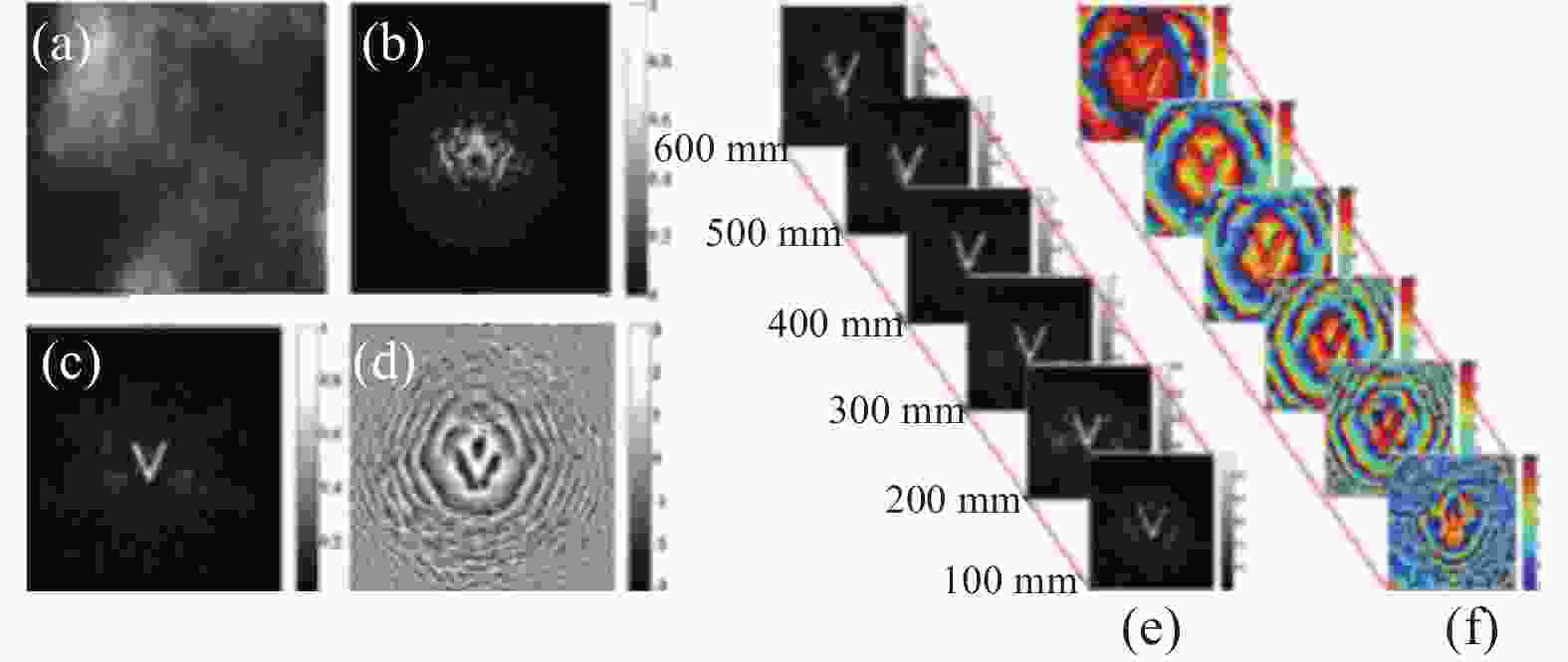
Figure 15. Experimental results. (a) The recorded speckle pattern of the object V; (b) The recovered coaxial hologram; (c), (d) The recovered amplitude and phase distributions; (e), (f) Amplitude and phase distribution of each plane after restoration to GG1[54]

Figure 16. Experimental setup for phase imaging of target behind scattering medium. Laser: He-Ne laser; MO: Microscope objective; P: Pinhole; HWP: Half-wave plate; BS: Beam splitter; M: Mirror; SLM: Spatial light modulator; L1, L2, L3: Lenses; GG: Ground glass; CCD: Charge coupled device[55]

Figure 17. Imaging performance using eight-step phase-shifting method for number 2 as test object. (a) Static conditions; (b) With vibrations; (c) Dynamic conditions[55]
同年,该课题组提出在鬼成像系统中引入离轴全息的方法[56],将参考光场与鬼成像系统产生的光场混合,分别利用两个探测器D1和D2检测物场强度和参考场强度,如图18所示,由于两个探测器在同一个平面上,分别拍照一次就能获得所需的强度图,减少更换CCD时产生的误差,使系统的鲁棒性更高、操作更简单。然后通过光强互相关计算获取两个光场的相关全息图,并对相关全息图进行数字化处理,实现物体振幅和相位信息的同时恢复,实验结果见图19。该方法利用了赝热光源瞬时光场的空间统计特性,无需长时间探测的时间平均,极大提高了成像速度。
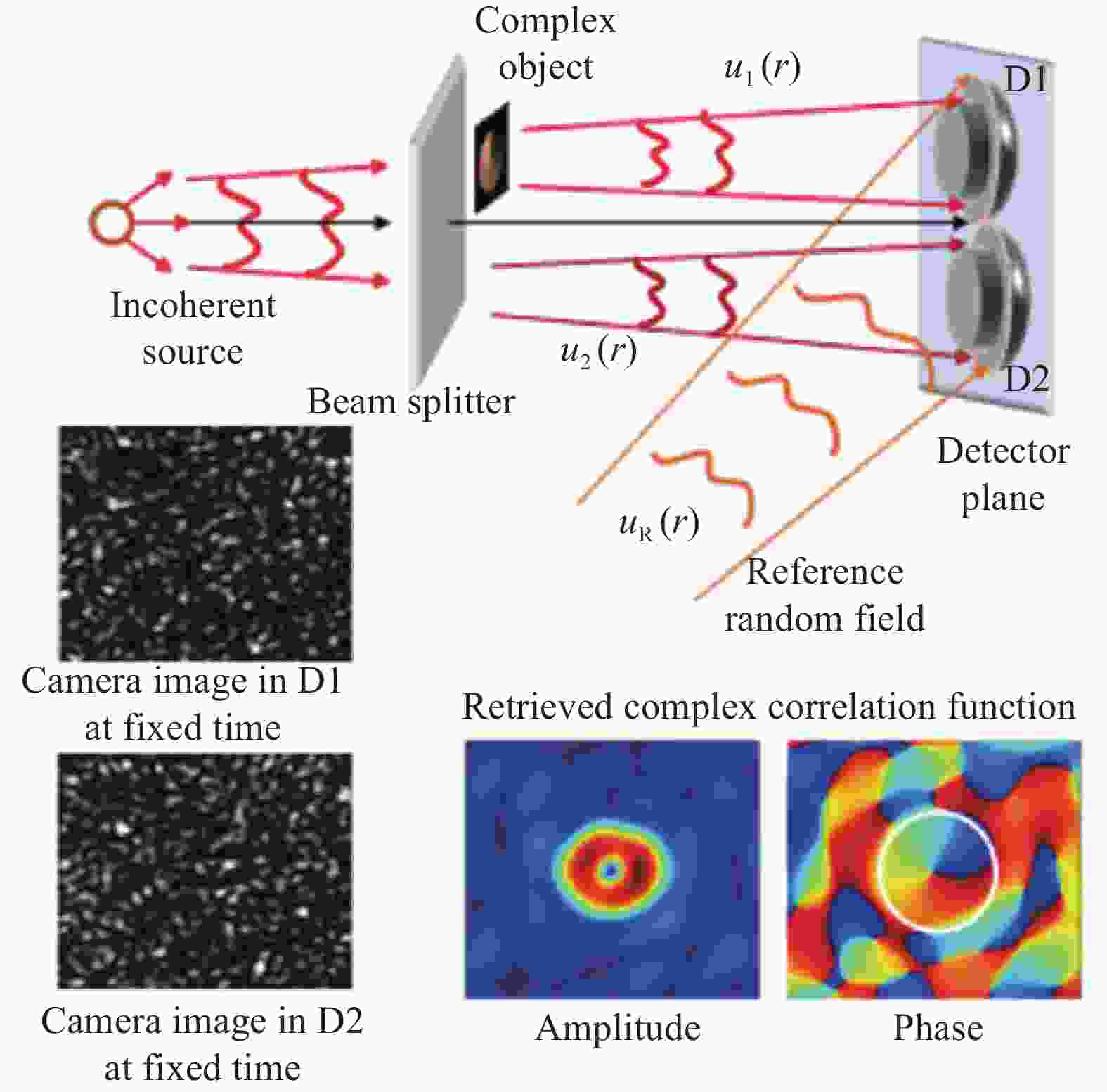
Figure 18. Principle of ghost diffraction holography[56]
相关全息技术将散射光场信息数学统计为空间相关函数,与散斑相关全息技术相比不需要复杂的相位迭代计算过程,为散射三维光场的恢复开辟了新的方向。但是相关全息图像需要通过干涉仪恢复,实验光路比散斑相关全息更复杂,未来还需进一步简化系统的结构。

Figure 19. Experimental results of ghost diffraction holography (upper) and ghost diffraction holographic microscopy (down) for different scale bars. (a)-(f) 1.15 mm; (g)-(j) 34.5 μm; (k) 23.0 μm ; (l) 11.5 μm[56]
-
基于全息技术的散射成像大多采用单波长光照明,不仅成像范围窄,还需要进行复杂的相位解包裹运算[57]。为解决上述问题,2006年,Hayasaki提出利用双波长数字全息技术实现散射成像[58],极大地推动了数字全息技术在散射成像领域的应用。
通过调节可调谐激光器的波长,得到两光束的波长分别为
$ {\lambda _1} $ 和$ {\lambda _2} $ ,采用CCD相机获取两幅波长不同的全息图,计算两幅图像的合成全息图以及合成波长Λ,其中$\varLambda {\text{ = }}{{{\lambda _1}{\lambda _2}} \mathord{\left/ {\vphantom {{{\lambda _1}{\lambda _2}} {\left| {{\lambda _1} - {\lambda _2}} \right|}}} \right. } {\left| {{\lambda _1} - {\lambda _2}} \right|}}$ ,将合成的全息图以波长Λ沿光路逆向传播,即可得到被遮挡物体的图像。当两种波长的光源来自同一位置,且散射介质中的不均匀性为准静态时,入射到探测器上的场是高度相关的。这是因为两种波长的光所经过的光线路径几乎相同,路径长度波动也几乎相同。因此,相位差中蕴含被遮挡物体的信息,通过计算两幅图的相位差能有效恢复物体信息。2019年,Willomitzer等人[34]为了有效规避散射介质的有害影响,利用散射光中的光谱相关性,以合成波长全息(Synthetic Wavelength Holography, SWH)的方法在宽角度视场内恢复被遮挡物体的高分辨率全息图像,通过监测小于6 cm×6 cm的探测区域返回的散射光,可以在46 ms内记录完整的物体场,再现全息图具有高空间和时间分辨率,实验原理如图20所示。
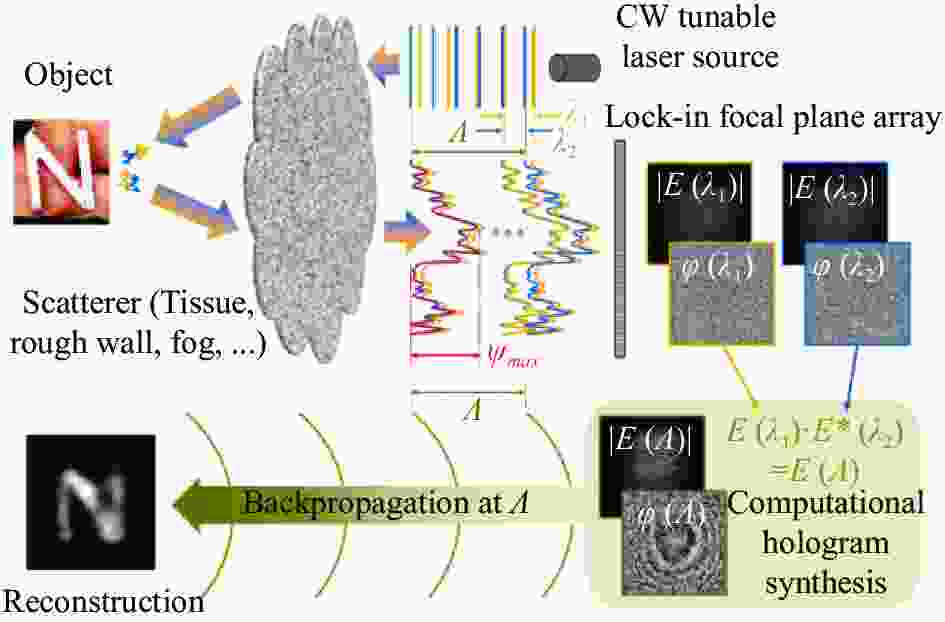
Figure 20. Schematics of SWH imaging through scattering media[34]
通过对两种不同类型的散射介质进行测量,如图21(c)所示,分别为220目的毛玻璃和4 mm厚的乳白色塑料板,图21(d)~(k)为重建结果。成像结果证实了该方法能够对隐藏在散射介质后的物体进行成像,当两束光的波长差变大时,合成波长变小,重建图中开始出现合成散斑的伪像,此时波长分离已经增加到光学全息图不相关的程度,严重影响散射成像的分辨率,使成像效果变差甚至无法成像。

Figure 21. Experimental results for measurements through scatterering media. (a) Experimental optical path; (b) Imaged character U with dimensions 15 mm×20 mm; (c) Scatterers used in the imaging path: A 220 grit ground glass diffuser and a milky plastic acrylic plate of 4 mm thickness, both placed 1 cm over a checker pattern to demonstrate the decay in visibility; (d)-(g) Reconstructions of measurements taken through the ground glass diffuser; (h)-(k) Reconstructions of measurements taken through the milky acrylic plate[34]
该课题组还提出将合成波长全息概念的基本原理扩展到多个波长[35]。通过记录许多有规则间隔的波长的场,计算出一个脉冲光源。其方式与光学相干层析成像(Optical Coherence Tomography, OCT)[59-60]和白光干涉测量(White Light Interferometry, WLI)[61-62]基本相同,不同的是不需要匹配两个干涉臂的功率和路径长度。相比于一个合成波长,多个合成波长全息技术能够有效恢复不同深度物体的信息,如图22所示,当合成波长的数量达到23个时,成功分辨出两个相距33 mm的物体,并且明显改善了散斑的伪影,提高了纵向分辨率。
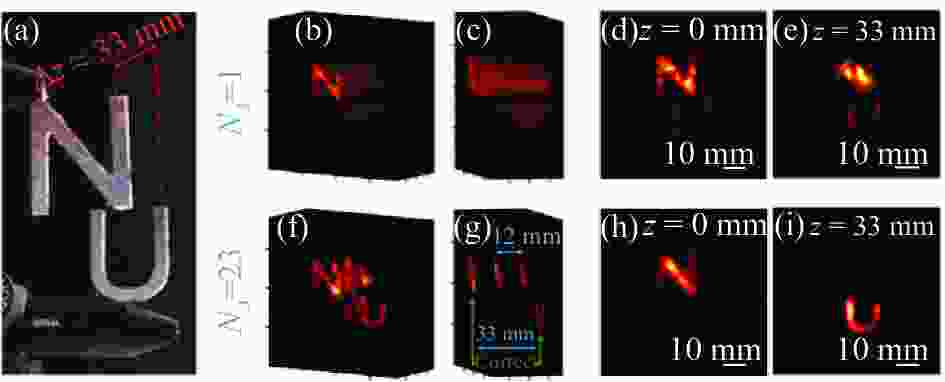
Figure 22. Experimental demonstration of synthetic pulse holography. (a) Target, consisting of two characters with a longitudinal separation of 33 mm; (b)-(e) Reconstruction of the characters, using only NΛ=1 SWL; (f)-(i) Reconstruction results when the number of synthesized wavelengths is 23; The pulse distance of the synthesized pulse train can be seen in (f) and (g) [35]
上述散射成像都致力于消除散射光的有害影响,很少有利用散射光进行成像的研究。2021年,Willomitzer课题组提出利用散射光对隐藏在角落的物体进行非视域成像(Non-Line-of-Sight, NLoS)[35,63],如图23所示,将两束波长不同的光分别照射在散射介质(例如墙)上,使发出的散射光照亮探测的目标,然后利用CCD相机收集由目标返回的散射光,计算合成波长全息图然后沿光路逆向传播,即可对目标进行非视域成像。

Figure 23. Experimental setup for the NLoS geometry. (a) Imaging schematic; (b) Picture of the experimental NLoS setup; (c) Closeup image of the rough target surface; (d) Image of the used targets: Two characters N and U with dimensions 15 mm×20 mm (plus black mountings); (e) Injection of the reference beam with a lensed fiber needle for a minimized light loss[35]
该方法的成像结果如图24所示。随着合成波长Λ的降低,重建的分辨率提高,这一特性与经典全息学的结果一致。理论上通过减小合成波长可以无限制地提高重建分辨率,然而实验结果并非如此。当Λ的值越小时,两束光的波长差越大,导致全息图不相关[64-65],重建图像会出现斑点状的伪像(见图24(f)~(j)),甚至于无法观察到隐藏的物体,因此针对不同的散射介质需要选择与之适应的合成波长Λ。

Figure 24. Experimental demonstration of looking around corners using SWH[35]
相比于其他的散射成像技术,双波长合成全息技术实现透过散射介质成像时,在无散射介质先验信息的条件下,仅需将合成的全息图像沿光路逆向传播就可以获得目标的复振幅信息,无需采用复杂的迭代相位恢复算法。由于该方法不受光学记忆效应等的限制,所以可以实现宽视场成像,但其也面临着从散射场中极弱干涉信号有效提取的问题,这是其保证成像能力的关键。
-
随着计算机处理能力的提升,以数据为驱动的机器学习发展极为迅速,其中深度学习因其强大的“逆问题”求解能力被国内外学者纷纷引入全息成像中来解决同轴全息产生的“孪生像”问题,深度学习技术是从大量的样本数据集中学习系统输入与输出之间复杂的高维度关联,包括系统存在的误差与不确定因素,因此往往能够实现非线性成像。目前,深度学习主要的基础模型有卷积神经网络(Convolutional Neural Networks, CNN)、循环神经网络(Recurrent Neural Network, RNN)、生成对抗式网络(Generative Adversarial Networks, GAN)等[66]。
2017年,美国加州大学的Rivenson等人[67]证明通过CNN训练相位恢复算法和全息图像的重建过程,能够快速有效消除孪生像的影响(见图25(a))。2018年,该课题组又提出一种能够同时执行自动聚焦和相位恢复的深度学习同轴全息图的重建方法[68],通过随机散焦的全息图像及其对应的焦内相位恢复图像对CNN进行训练,显著提高了视场的景深以及重建速度。同年,中国科学院上海光学精密机械研究所司徒国海等人[69]提出同轴全息图端到端的eHolo-Net深度学习重建技术,实现了从单张同轴全息图中重建物体的相位信息(见图25(b))。2019年,西北工业大学赵建林等人[70]提出了一种端到端重建的Y-Net结构,并且从单张全息图中同时恢复了物体的振幅和相位(如图25(c))。此外,基于深度学习的全息技术在显微成像方面也有研究,2019年,Ozcan等人[71]提出一种基于GAN的深度学习框架来实现全息系统的超分辨率成像,该方法突破了显微物镜数值孔径的限制,不需要任何额外的参数优化并且能够广泛应用于各种相干成像技术。
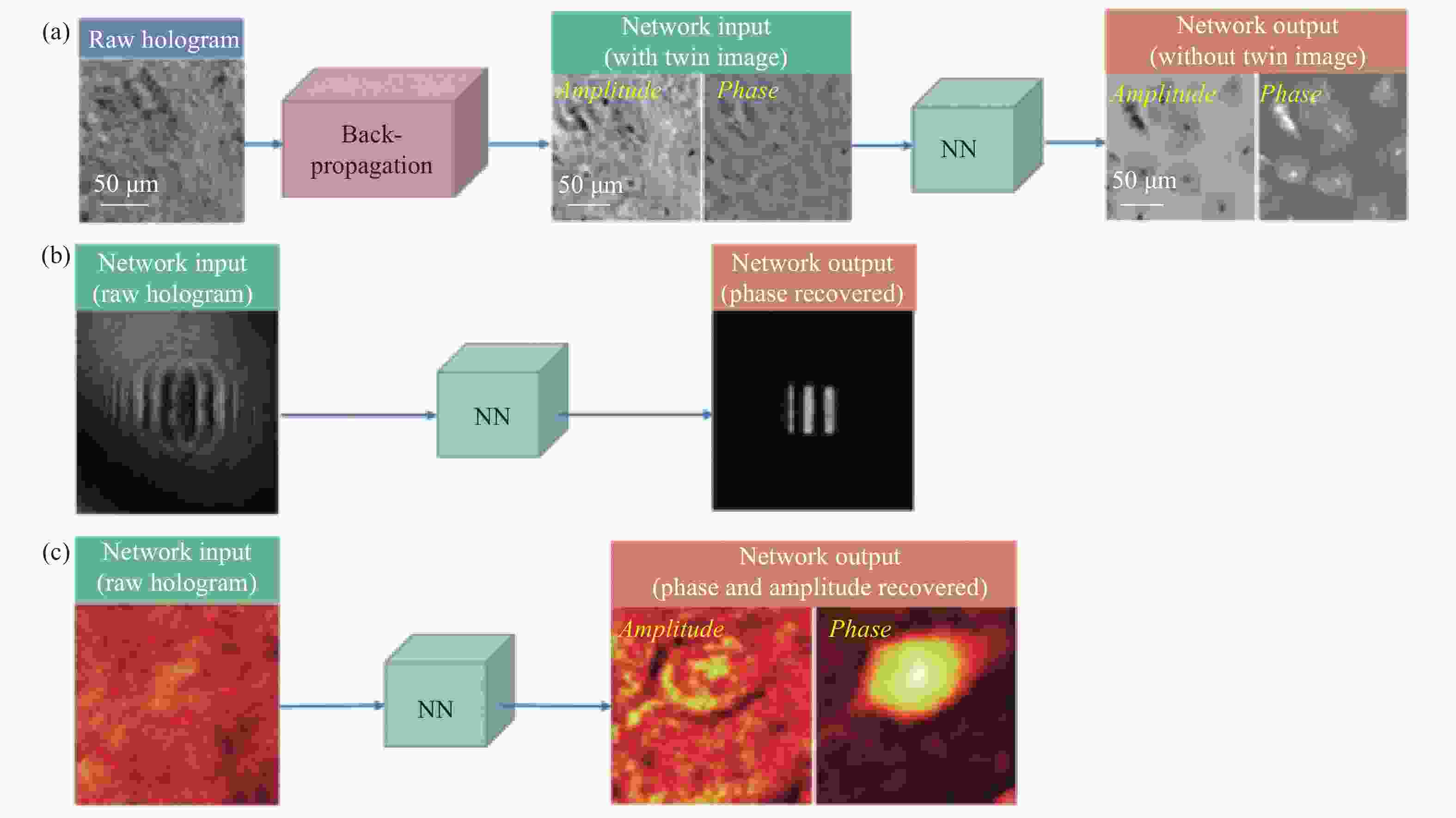
Figure 25. Applications of deep learning in digital holography. (a) Removing twin image; (b) End-to-end phase reconstruction; (c) End-to-end complex amplitude reconstruction[72]
然而实际成像链路中不可避免地受到散射介质的影响,为了将基于深度学习的全息技术更广泛地应用到实际生产生活中,2020年,司徒国海等人[73]首次提出利用该技术实现透过散射介质成像,将eHoloNet神经网络结构用于短相干数字全息术成像中,实验光路如图26所示,通过研究不同散射介质对神经网络性能的影响,该技术实现了从单幅全息图中重建动态散射介质后的目标,推动了深度学习全息技术在散射成像中应用。

Figure 26. Learning-based short-coherence digital holographic imaging [73]
同年,Zhang等人[74]提出将生成对抗网络GAN用于学习散斑图和GS(Gerchberg-Saxton)算法计算得到的相位图之间的函数关系(如图27所示),该方法证明了深度学习网络通过学习散射介质的散射机理来实现透过散射介质成像(如图28所示),并且该方法能同时恢复图像的低频和高频信息,进一步突显出图像的细节,具有良好的泛化性能。虽然深度学习的引入为数字全息成像和穿透散射介质成像带来的新的可能,但在实际情况下,特别是散射成像应用中预先训练样本的获取是极难甚至是不可能的,小样本或样本泛化是将来深度学习实际应用的一大挑战。
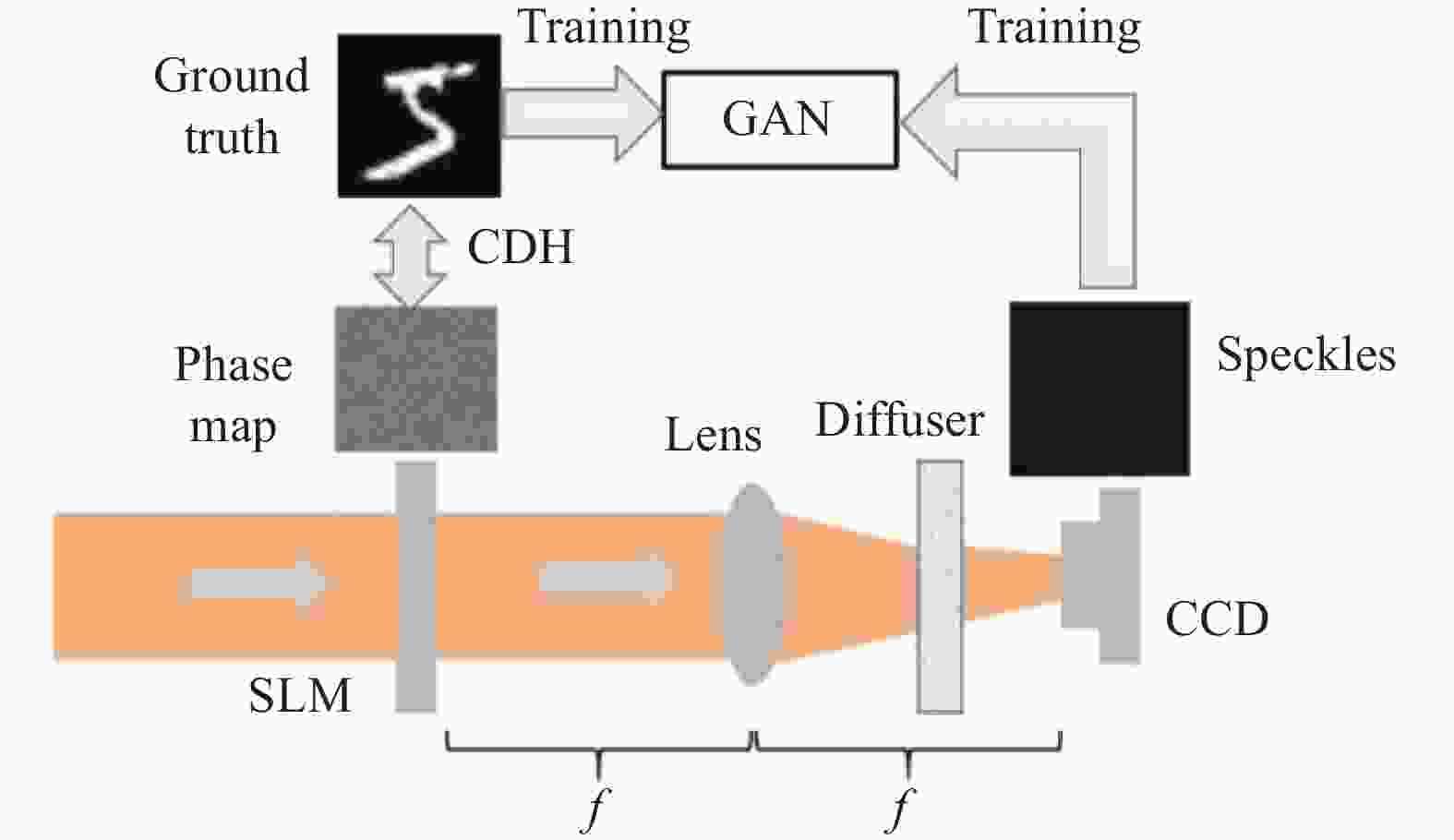
Figure 27. Computational holographic imaging system based on deep learning [74]

Figure 28. Result of computational holographic imaging system based on deep learning [74]
为便于对以上几种技术的特点进行对比,在表1中进行了简单归纳,分析了它们在散射成像应用的几个关键方面的优劣势。
Computational
complexityImaging through
dynamic mediaPenetration Field of view Coherent gating type ★ ★★★ ★ ★★☆ Phase conjugation type ★★ − ★ ★★ Correlation
type★★★ ★★ ★★★ ★ Synthetic wavelength type ★★ ★ ★★ ★★★ Deep learning type ★★★ ★★ ★★ ★★☆ Table 1. Comparison of scattering imaging methods based on holography
-
全息成像技术作为一种能同时记录目标振幅与相位的成像技术在穿透散射介质成像领域的应用潜力巨大。目前,无论是在弹道光提取应用领域中的全息相干门控技术,还是弥补散射介质相位影响的相位共轭全息技术,又或是解译散斑场统计信息的相关全息成像技术和瞄准不同波长下散射特性差异的双波长全息成像技术等已在实验室中展现出优异的实验结果。在相位信息调控与获取上的独特优势展示了其在穿透散射介质成像领域的巨大的发展潜力。
即便基于全息技术的散射成像取得了一系列的成果,但是仍存在一些难点问题需要解决如下:(1)无参考光成像。目前全息技术中大多需要引入参考光,导致光路复杂,如何避免引入参考光,仅利用成像目标光束是下一步需突破之处;(2)动态散射介质成像。实际应用环境复杂多变,往往需要透过动态的散射介质成像,因此提升全息成像技术的实时性是未来应该面对的挑战。(3)低相干性照明成像。相干光全息成像受伪像的干扰,降低光源的相干性能有效避免这种干扰,因此利用低相干性光源成像是进一步研究的重点。(4)多维度信息提取。光波中含有振幅、相位、偏振、光谱等多维信息,而目前成像技术未将其中全部维度信息加以利用,造成了信息的丢失,因此提升多维度信息利用率为未来研究要突破的重点问题。
除了以上需要解决的问题外,全息散射成像技术在未来具有研究意义的方向为:(1)进一步优化深度学习在全息重建中应用,如何利用小样本进行高质量的网络训练,克服孪生像对成像的干扰,提升迭代速度及准确度,是未来要探究的方向。(2)目前已有的研究集中在规避散射介质影响这方面,但实际生活中大部分情况都是将散射介质视为获取不可见目标光的媒介,因此未来必然是向着散射光的利用这方面发展,这种发展路径下的相关技术可以应用到非视域成像领域中。
综上所述,基于全息术的散射成像需要获取的散斑图像数量少,往往是单帧探测;成像重建不依赖于不确定的迭代求解,抗干扰能力强;无需先验信息。在三维成像、显微成像、透过散射介质以及非视域成像等方面都取得了不错的成像效果,为生物医学检测、浑浊水下成像、火灾救援等应用提供有力的解决方案,有着广阔的发展前景。随着研究的不断深入,基于全息术的散射成像技术有望突破目前技术中的受限的瓶颈,更多地应用到实际生活中。
Research and application progress of holography technology in scattering imaging (invited)
doi: 10.3788/IRLA20220307
- Received Date: 2022-04-29
- Rev Recd Date: 2022-07-19
- Available Online: 2022-08-31
- Publish Date: 2022-08-31
-
Key words:
- scattering imaging /
- computational imaging /
- phase conjugate holography /
- synthetic wavelength holography /
- correlation holography
Abstract: Scattering is an ordinary phenomenon in optical imaging. The imaging light is scattered by scattering media, such as smoke, water and biological tissues, existing in imaging path. The influence of scattering disturbs the imaging target information from orderly pattern to random speckles on imaging plane. How to break the limitation of scattering media is an essential problem in the field of optical imaging. Holographic technology can record and reconstruct all the information of objects, and play an important role in light field information obtaining and interpreting. In recent years, traditional holography and correlation holography theories have been applied to the field of scattering imaging, and a series of outstanding results have been achieved. This paper mainly introduces and summarizes the theoretical principles, development and latest achievement of holography technology in the field of scattering imaging. And the vista of holographic scattering imaging is also discussed.













 DownLoad:
DownLoad:

